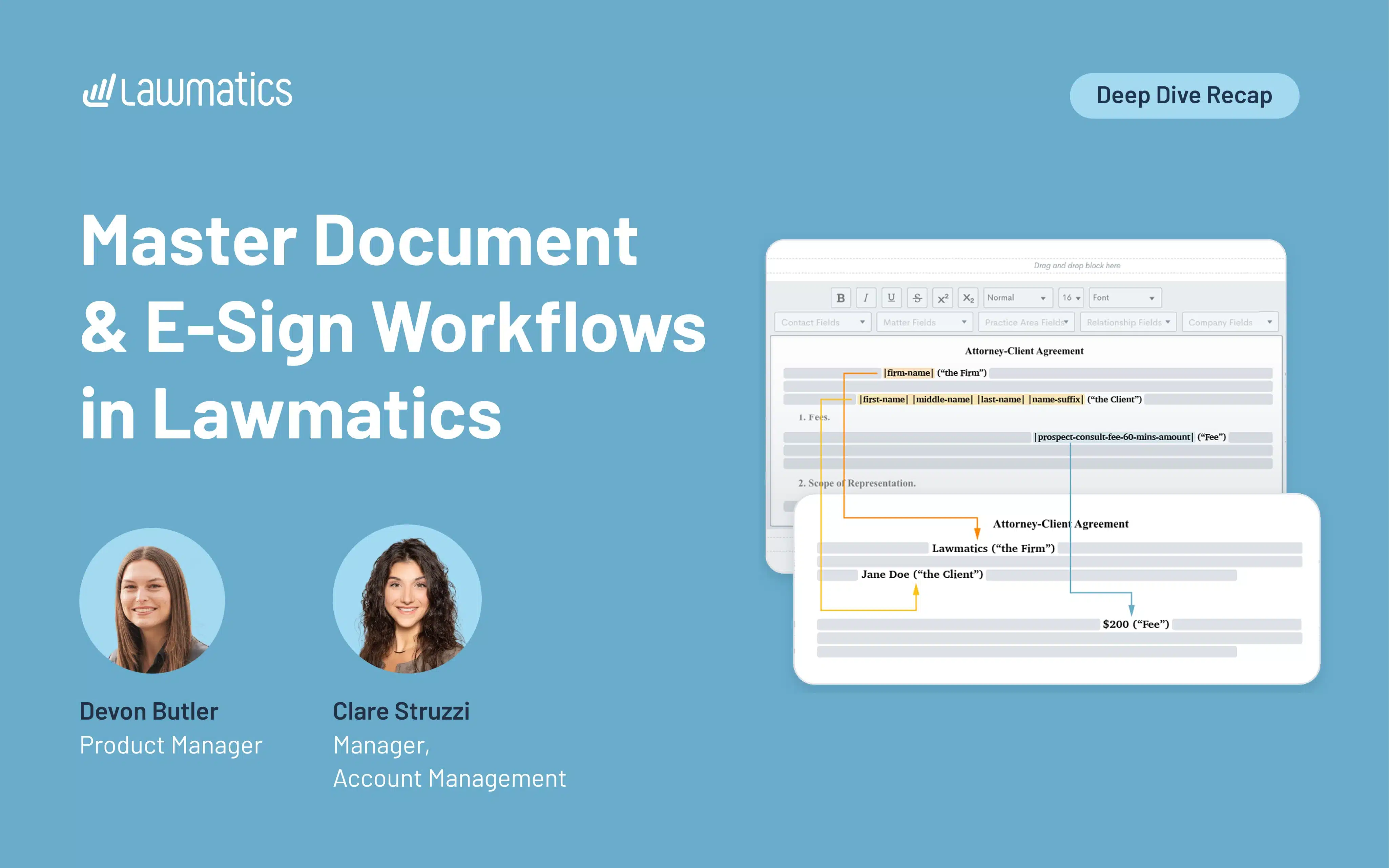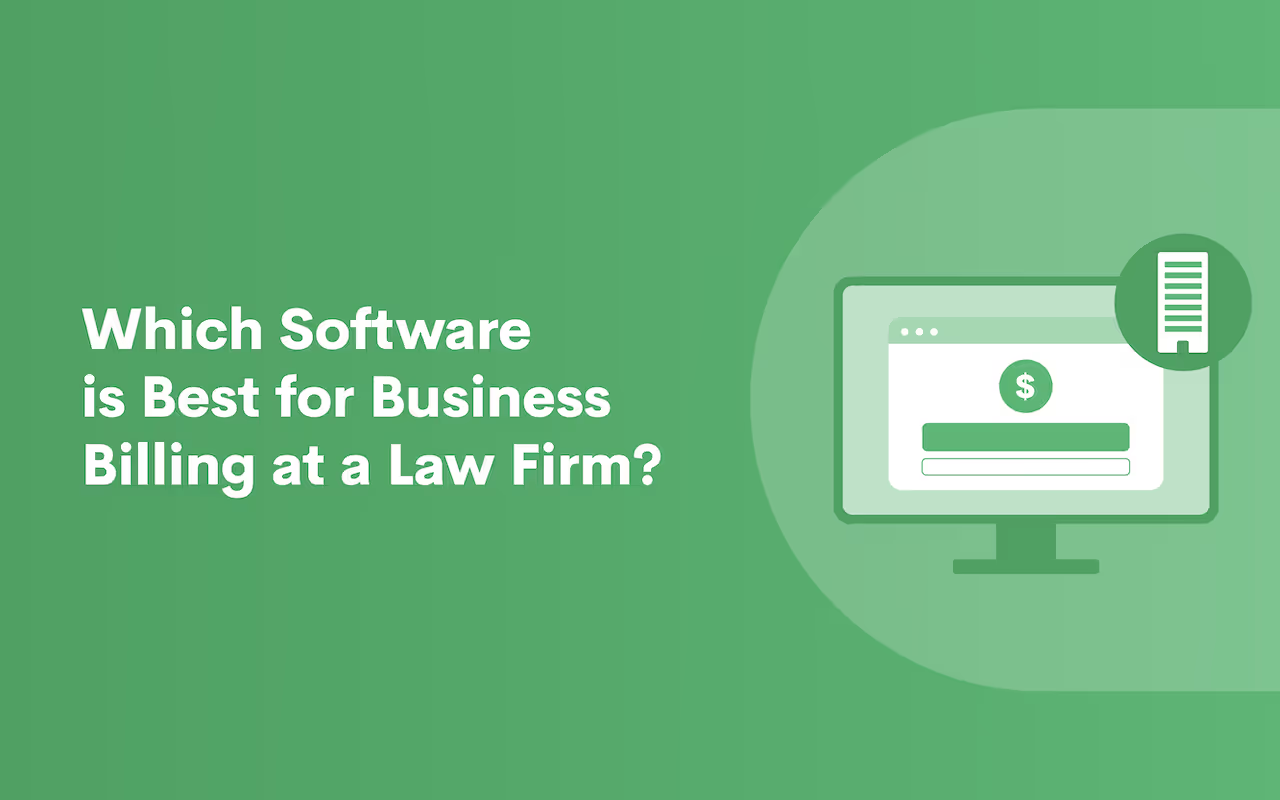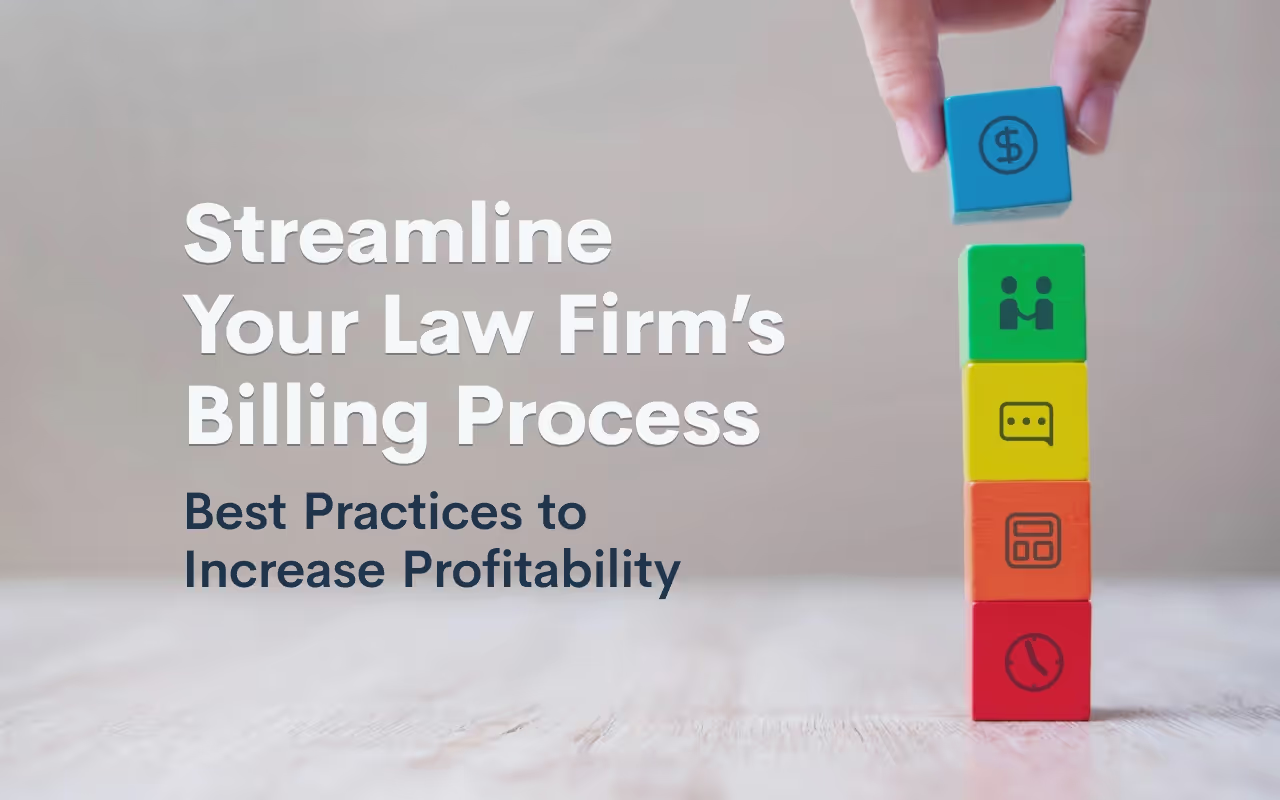Time & Billing
As we head toward the end of the year, our team revisited the most meaningful product updates of 2025 and how they’re reshaping the way firms work. All year long, our product work has centered on the same core goal: removing the obstacles that slow firms down. That’s meant bringing key information to the surface when teams need it, cutting out friction in the client journey, and giving staff clearer ways to build and maintain their processes across the platform.
Time stamps of key takeaways
8:15 – New, intuitive navigation
Devon walks through the redesigned navigation, which brings the most-used areas — like Matters, Pipeline, Calendar, Tasks, and Automations — into a cleaner, left-hand layout for quicker access. Reminders, emails, and other tools that had previously been scattered across the app now live in central, easy-to-find locations. The goal is simple: fewer clicks, clearer groupings, and a workspace that reflects how firms actually move through intake.
26:20 – Get key info faster with MMS
The team shows how firms can now receive MMS messages directly into Lawmatics, allowing clients to text photos or documents straight into their matter. It’s especially useful for practices like personal injury, where images of an accident or ID documents are often needed quickly.
31:18 – Manage your emails in one place
Email tools have been fully centralized, replacing the old model where templates lived in different corners of the app. Everything — from document send templates to automation emails — can now be created, edited, and organized in one place. Folders help firms manage growing libraries of emails, and each template can be applied across multiple documents without duplicate versions.
36:55 – Build and maintain automations with less effort
Devon and Clare highlight the refreshed automation experience, which makes appointment-based and date-based workflows easier to find, build, and understand. Relative timing is now built directly into each automation, and shared entry rules help firms avoid recreating the same logic dozens of times. Automation builds can also now be grouped in folders, similar to how you organize your email library.
45:18 – Additional highlights
The session closes with a handful of smaller but long-requested additions, including improvements to round-robin scheduling, password-protected forms, Message Center filters, auto-pay for billing, and color-coded appointment types to make dense calendars easier to read.
Webinar slide deck
Legal time tracking software is a tool that enables lawyers to capture their billable work for invoicing clients and tracking expenses. Some of the top time tracking software solutions on the market include Lawmatics, Bill4Time, Memtime, and Smokeball. Lawmatics uniquely combines time tracking with CRM capabilities for complete firm growth management.
You’re a busy lawyer building the best cases for your clients. The last thing you need is to spend hours each week trying to remember which meetings, emails, and research sessions were billable.
Manual time tracking doesn't just create administrative headaches — it costs you money. Every unbilled hour is lost revenue.
Legal time tracking software fixes this with automations, invoice templates, and reporting tools that capture billable moments as they happen. No more memory exercises.
But, not all time trackers are created equal. Here we’ll break down the top options to simplify your search.
Why Does Attorney Time Tracking Matter for Law Firms?
Time tracking is your firm's profit engine. With in-app timers and one-click entries, attorneys record time within their workflow, so no profitable work goes unbilled. More efficient tracking means better utilization and realization, leading to more revenue.
Time management software for lawyers improves billing efficiency and client satisfaction. Office managers and accountants stop chasing attorneys for data since these platforms automatically collect, organize, and generate invoices.
Clients receive bills promptly instead of months later, increasing collection rates. Plus, client portals and e-payments make paying simple, allowing clients to review billing history and pay directly from invoices. A better experience for them means faster cash flow for you.
These tools also simplify compliance with e-billing regulations, including the Legal Electronic Data Exchange Standard (LEDES) and Uniform Task-Based Management System (UTBMS) codes. Instead of manually formatting invoices, the software does it automatically and even suggests correct codes to reduce rejections.
Most platforms include safeguards for ethical trust account maintenance, ensuring proper handling of client funds. Transactions tie to case matters and bank statements for auditable records that meet state bar and government regulations.
See what some of these features look like in action. Explore Lawmatics Time Tracking Software.
Best Legal Time Tracking Software for Lawyers in 2025
Whether you need simplified time entry or detailed billing reports, here are the top legal time tracking solutions.
1. Lawmatics: Best legal time tracking tool + legal CRM capabilities
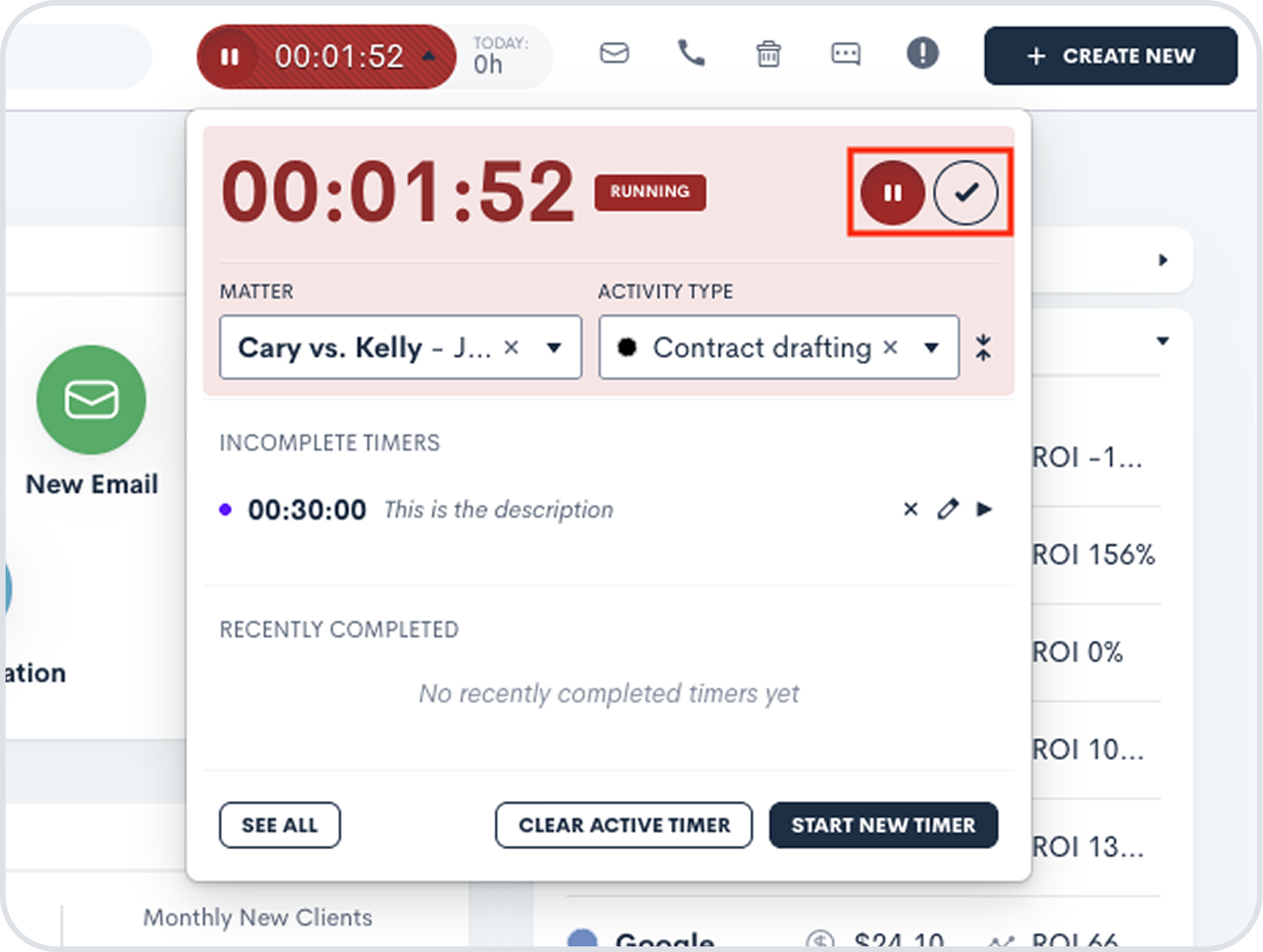
Lawmatics offers time tracking and billing functionality on top of its client relationship management (CRM) solution. By combining these two tools, you’re able to handle the two main growth drivers for your law firm in one place: client marketing and revenue management.
In particular, Lawmatics' time tracking features prioritize your clients’ needs, such as e-payment options, client portals, and detailed invoices, making it easy for clients to understand and pay what they owe faster.
You also gain visibility into key metrics, such as productivity per staff member, for smarter resource decisions. Attorneys spend less time on administrative work and more time preparing for cases, resolving matters, and building lasting relationships with clients.
Features:
- Legal time tracking.
- Time and billing.
- Expense tracking and invoicing.
- Client intake.
- Custom automations.
- Document automations.
- Flexible billing rates (hourly, fixed, and contingency).
- Integrations with other legal platforms like Clio, PracticePanther, and Smokeball.
- Legal marketing and CRM.
- Custom legal reporting, dashboards, and analytics
Pricing: Contact sales for a quote. Three tiers are available (Essential, Premium, Enterprise) with a three-user minimum. Time and billing software is available as an add-on.
Key differentiator: Create law firm goals that align staff on efficient time tracking and marketing objectives.
2. Bill4Time: Best for transparent legal billing & timekeeping
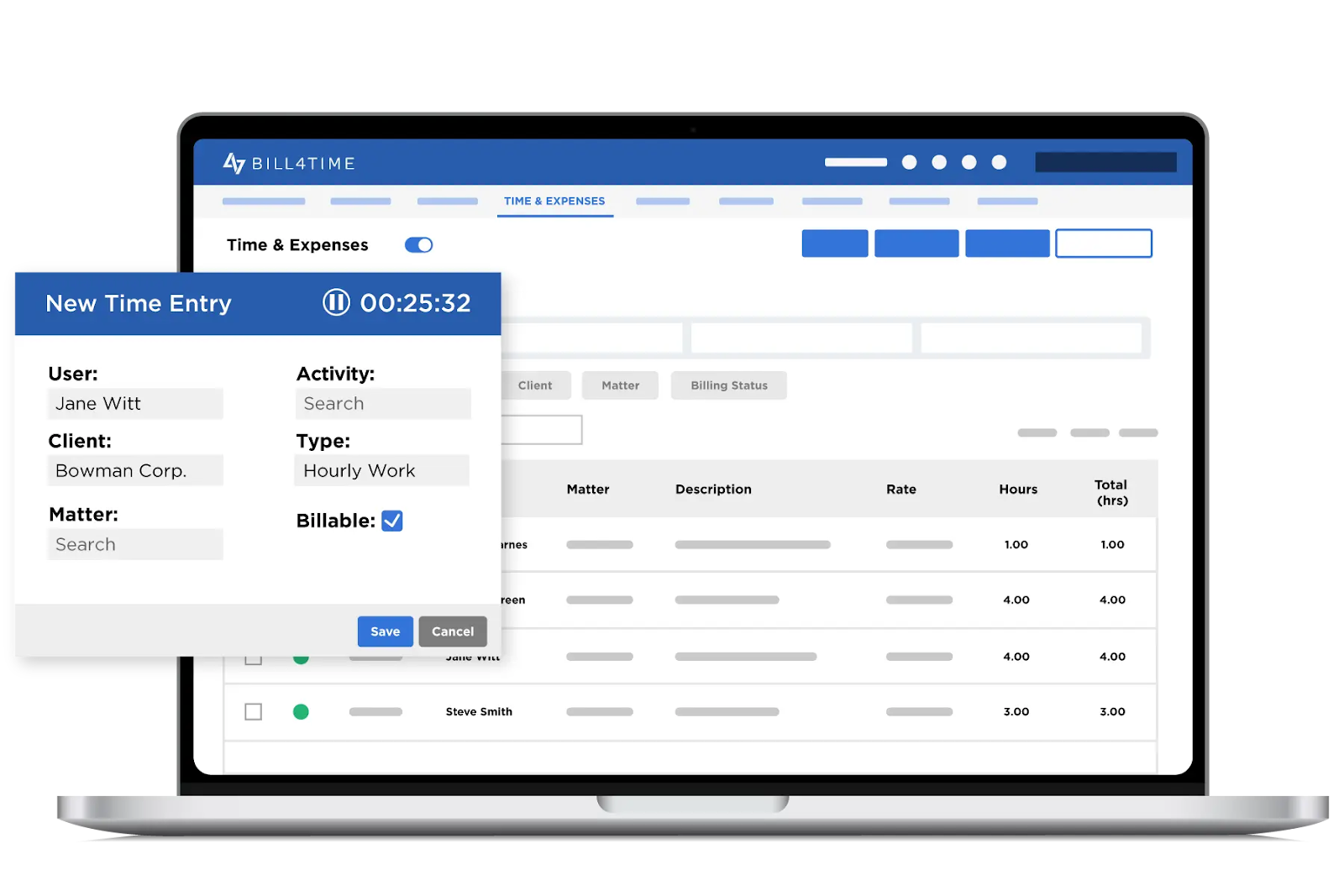
Bill4Time is a legal software tool offering time tracking alongside expense tracking, billing, and project management features. It lets you manage internal operations, like scheduling clients and collaborating on tasks, from one system.
The starter plan, Time & Billing, is ideal for small firms wanting basic accounting and practice management features at an affordable price.
Features:
- Time tracking.
- Task management.
- Payment processing.
- Invoice templates.
- LEDES compliance and UTBMS codes.
Pricing:
14-day free trial. Afterward (billed annually):
- Time & Billing: $27 per user per month.
- Time & Billing Enterprise: $67 per user per month.
- Legal Pro: $45 per user per month.
- Legal Enterprise: $80 per user per month.
Key differentiator: Transparent and scalable subscription plans for growing law firms.
3. Memtime: Best for automatic background time capture
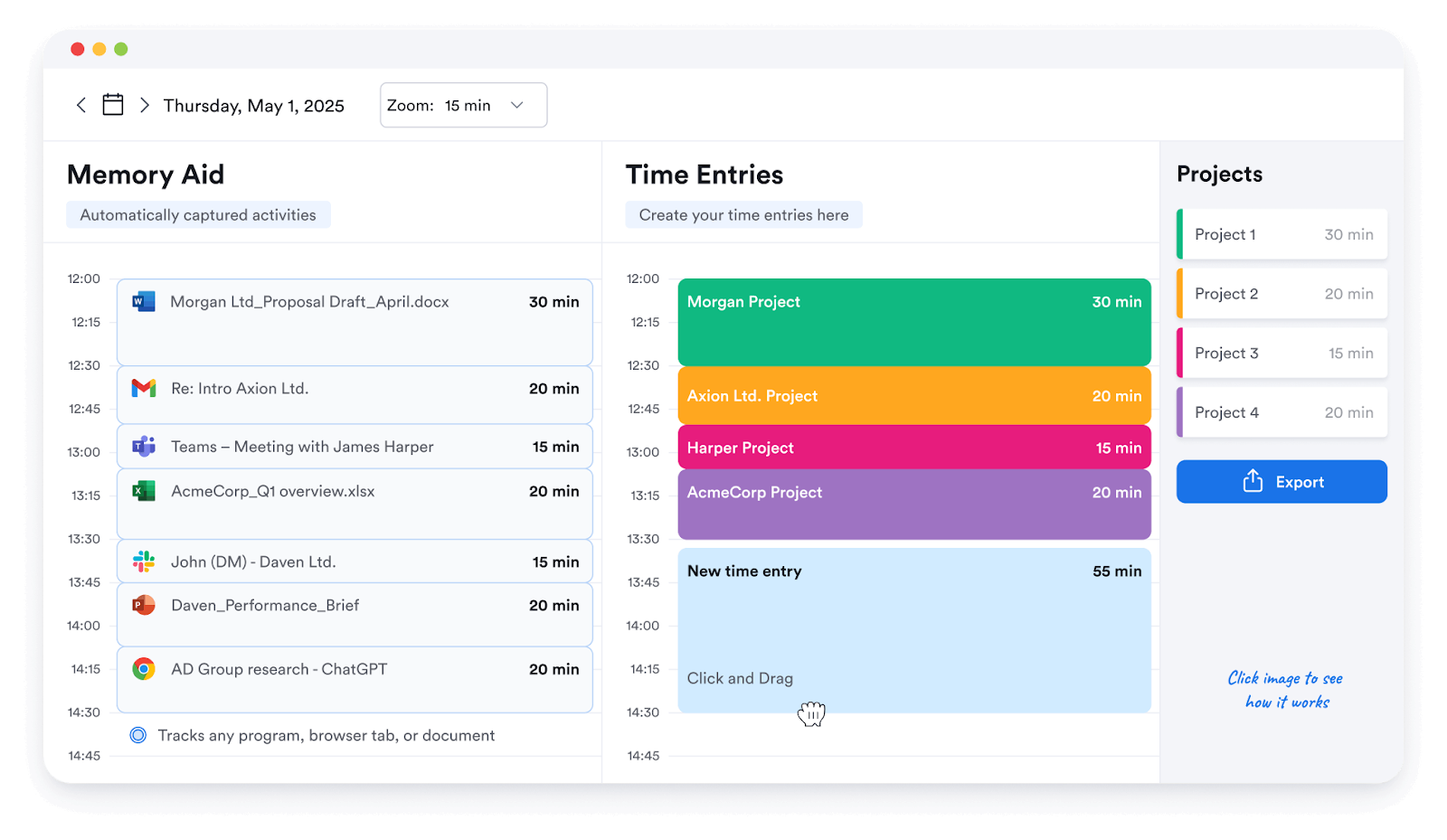
Memtime is an automatic time tracker that runs passively in the background to record all of your electronic activities. While not law-specific, it's perfect for lawyers who forget timers or constantly switch tasks.
Memtime keeps track of every activity for later assignment to the appropriate case, project, or matter.
Features:
- Automatic time capture.
- 100+ software integrations, including Clio, Asana, and Jira.
- Offline time entries.
- Windows, Mac, and Linux compatible.
- Adjustable time increments (6 minutes to 1 hour).
Pricing:
14-day free trial. Afterward (billed biannually):
- Basic: $12 per user per month.
- Connect: $18 per user per month.
- Premium: $23 per user per month.
- Enterprise: Contact sales.
Key differentiator: Captured time data is stored locally on users’ devices for complete data privacy.
4. WiseTime: Best for lawyers who dislike manual entry
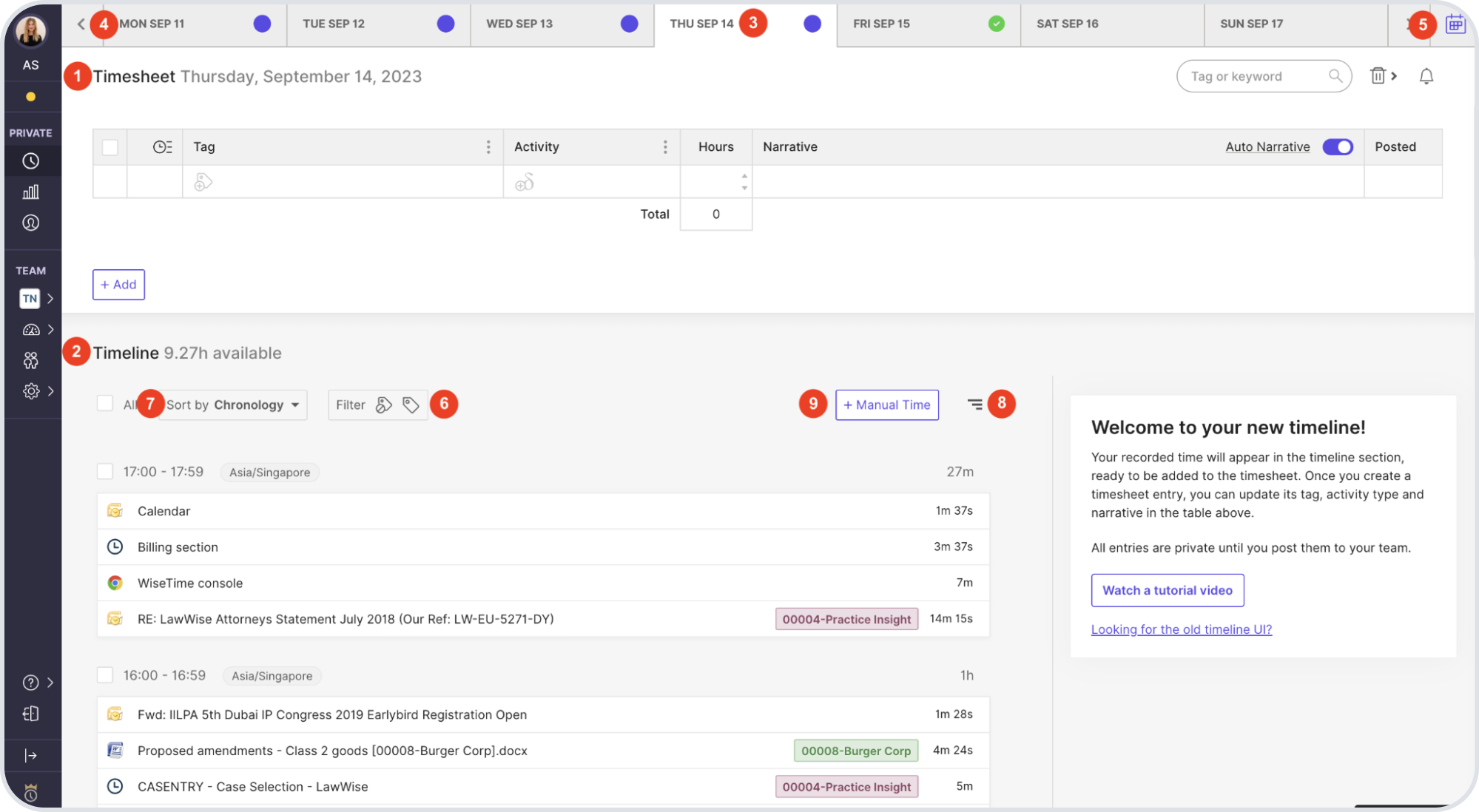
WiseTime by Anaqua is an automatic time tracking application purpose-built for legal teams. Unlike Memtime, WiseTime’s tracker identifies key information from activities and auto-tags them to the correct case. Lawyers spend minimal time sorting entries, dramatically reducing admin work.
Even better: The more you manage, assign, and correct auto-tagged time entries within WiseTime, the smarter its AI machine learning algorithms become. This leads to more accurate billing and faster payment.
Features:
- Autonomous timekeeping and case tagging.
- Team management controls.
- Privacy controls and General Data Protection Regulation (GDPR) compliance.
- Data lifecycle management.
- Integrations with legal software like Clio and PracticePanther.
Pricing: 30-day free trial. Afterward, contact sales for a quote for either its Professional or Enterprise subscription plans.
Key differentiator: AI-generated narratives that summarize your recorded activities, providing more detailed descriptions on clients' invoices.
5. Rocket Matter: Best cloud-based legal practice management + time tracking
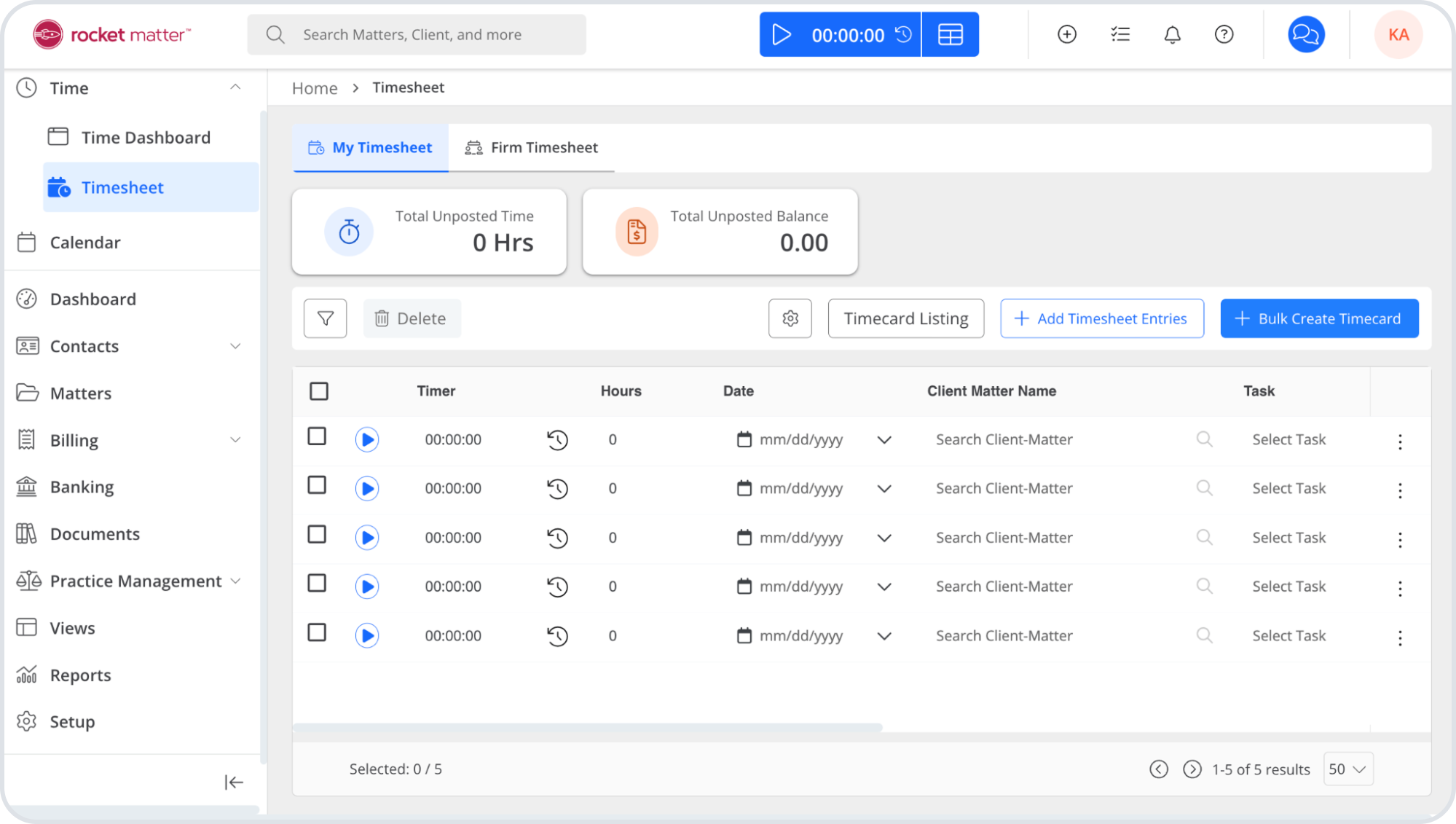
Rocket Matter by ProfitSolv is a scalable practice management suite with time tracking in all of its subscription plans. Time tracking is tied into its billing and matter management features, allowing staff to capture the maximum amount of billable hours without interrupting focused work.
Rocket Matter also includes advanced time tracking capabilities, such as the ability to run multiple timers, multi-device accessibility, and automatic time entries to reduce task oversight.
Features:
- Time and expense tracking.
- Individual, team, and firm-level dashboards and analytics.
- Time tracking within Outlook emails.
- Interest on Lawyers Trust Account (IOLTA) trust accounting compliant.
- Mobile capability.
Pricing:
10-day free trial. Afterward (billed annually):
- Essentials: $39 per user per month.
- Pro: $69 per user per month.
- Premier: $99 per user per month.
- Elite: $129 per user per month.
Key differentiator: White glove service with all plans, including a dedicated account manager and support via phone, email, and chat.
6. FreshBooks: Best budget option for small firms

FreshBooks is a small business accounting program that includes features like time tracking, mileage tracking, team management, and payroll. While not legal-specific, solo or boutique legal firms will appreciate managing all financial tasks in one system without the need for extra integrations.
FreshBooks' time tracking features are largely basic, allowing you to stop and start timers and assign projects and clients to each activity.
Features:
- Team collaboration to track time toward the same projects and clients.
- Chrome Timer Google Chrome extension.
- Budget management and automatic billing.
- Expense tracking.
- Business performance dashboards.
Pricing:
30-day free trial. Afterward (billed monthly):
- Lite: $21 per month.*
- Plus: $38 per month.*
- Premium: $65 per month.*
- Select: Contact sales.
You can add the following to any plan:
- Team members: $11 per month per user.
- Advanced payments: $20 per month (included with Select plan).
- FreshBooks payroll: $40 plus $6 per user per month.
*Note: FreshBooks currently has a 50% off for six months promotion. Check its website for details.
Key differentiator: Time entries connect to invoices, which flow into your general ledger for seamless accounting.
7. TimeSparrow: Best for simplicity & speed
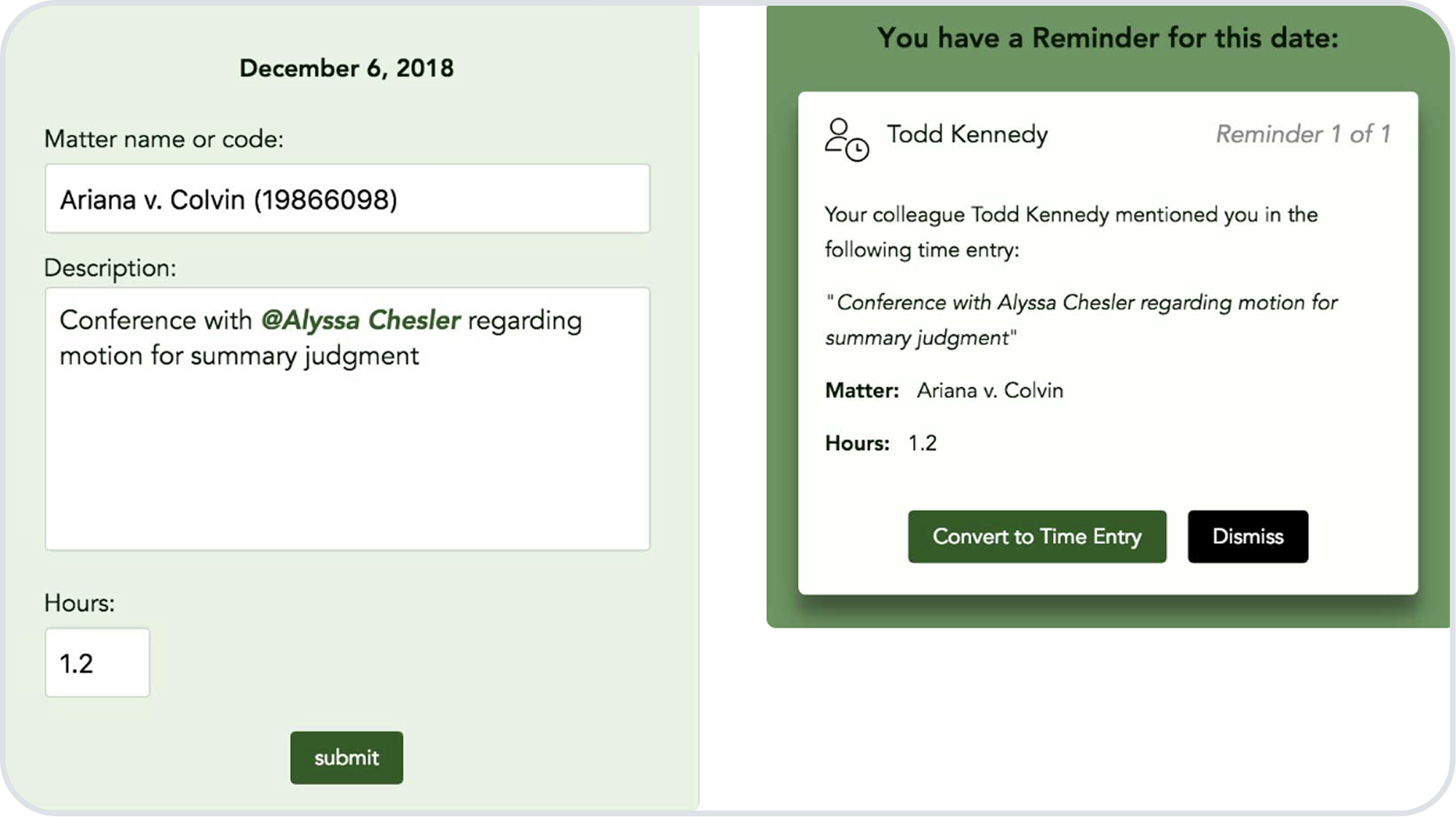
Although purpose-built for legal teams, TimeSparrow’s time tracking software is best for solo practitioners or firms with fewer than five lawyers. This is because TimeSparrow lacks most of the automations, integrations, and billing features of others in this roundup.
TimeSparrow compensates for this with extreme ease of use, such as simple implementation and interface navigation to encourage firm-wide adoption.
Features:
- Manual time entry or in-app timers.
- Enter time entries through email, texts, or Amazon Alexa.
- Phone call time entry transcriptions.
- Integration with DocketBird.
- Colleague reminders.
Pricing:
30-day free trial. Afterward:
- Contact sales for pricing.
- Volume discounts available for firms with more than 10 users.
Key differentiator: No hidden or additional fees for data migration, implementation, or maintenance.
8. Time Tracker by eBillity: Best for LEDES compliance
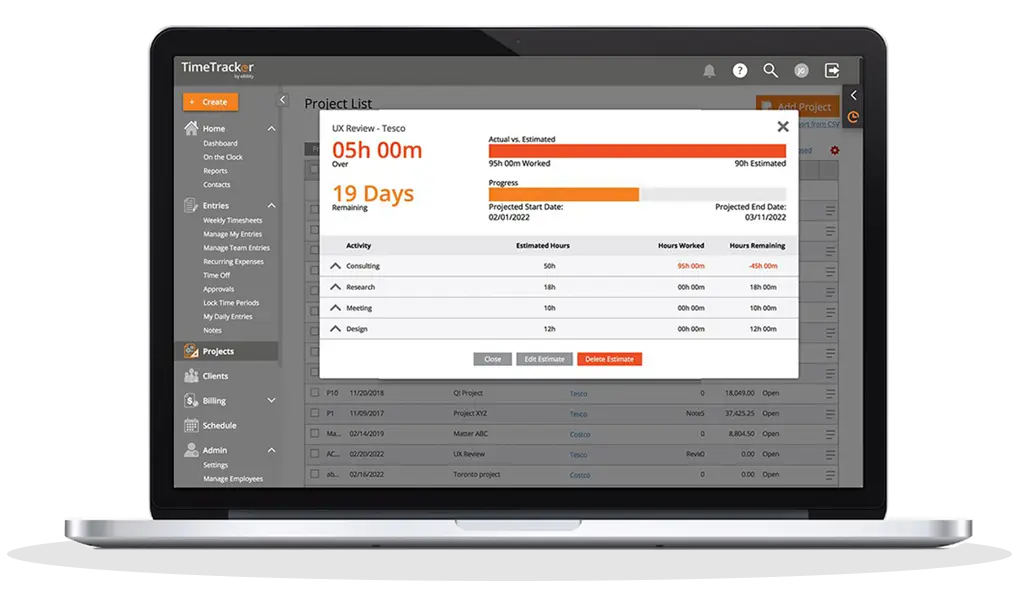
Time Tracker by eBillity is one of the most versatile time trackers, offering both legal-specific and employee management features. For example, it includes employee scheduling, GPS, and geolocation for non-exempt employee time tracking and payroll purposes.
Time Tracker integrates with case management, payroll, and accounting applications, including Clio, ADP, Gusto, QuickBooks, and Xero. It is also able to convert your time entries into LEDES and LSS-compliant invoice formats.
Features:
- Time tracking and invoicing.
- Client invoice portals.
- Windows 10 desktop app for offline mode.
- Mobile time tracking.
- Trust accounts.
Pricing:
14-day free trial. Afterward (billed annually):
- Time Tracker: $17.60 plus $11.20 per user per month.
- Time Tracker Premium: $24 plus $16.80 per user per month.
- LawBillity: $30 per user per month.*
*Note: Must purchase LawBillity subscription plan for legal-specific features, including legal invoicing formats, UTBMS codes, trust accounts, realization reports, and conflict checkers.
Key differentiator: Photograph receipts to record and attach expenses to invoices on the go.
9. Smokeball: Best for productivity insights + time tracking
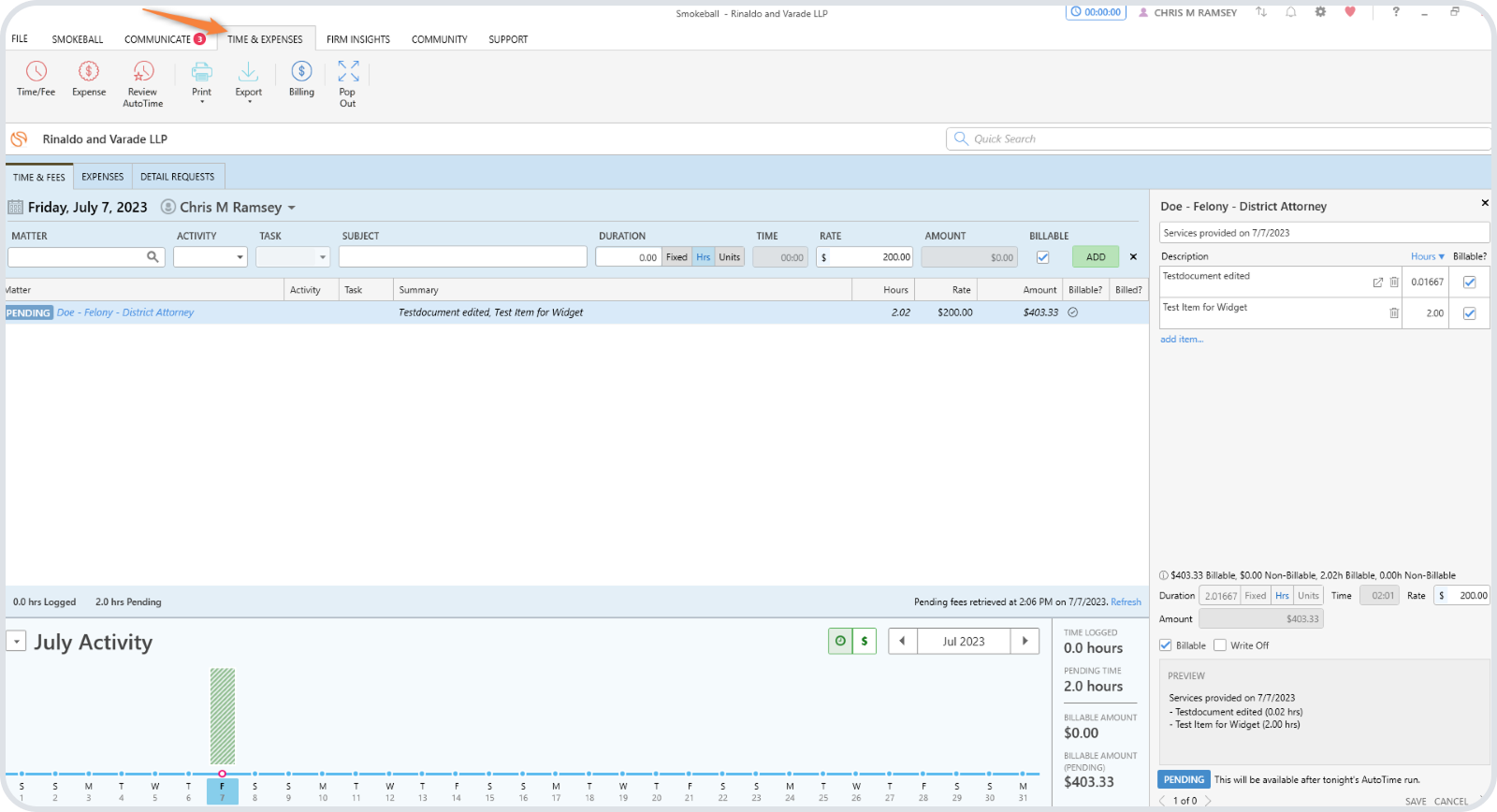
Smokeball is a comprehensive legal software that offers case, time, and billing management capabilities. As a result, it’s best for small-to-medium firms looking to centralize all of their business activities in one system.
Smokeball’s reporting and analytics capabilities allow you to monitor team activities and critical deadlines like upcoming court dates, settlement dates, or statutes of limitations. You can even segment data by matter, case type, or attorney to quickly identify which areas are driving the firm’s profits.
Features:
- Manual and AutoTime time tracking.
- Calendaring.
- Profitability reports.
- Automated workflows.
- Staff performance targets.
Pricing: Contact sales for a quote. Four tiers are available (Bill, Boost, Grow, and Prosper+). Add-ons like Intake and Archie AI Assistant are available for the Boost plan and up. The AutoTime add-on is available for the Grow plan and up.
Key differentiator: Workflow automation for task reminders and keeping staff on track with billable work.
10. LeanLaw: Best QuickBooks native time tracking for law firms
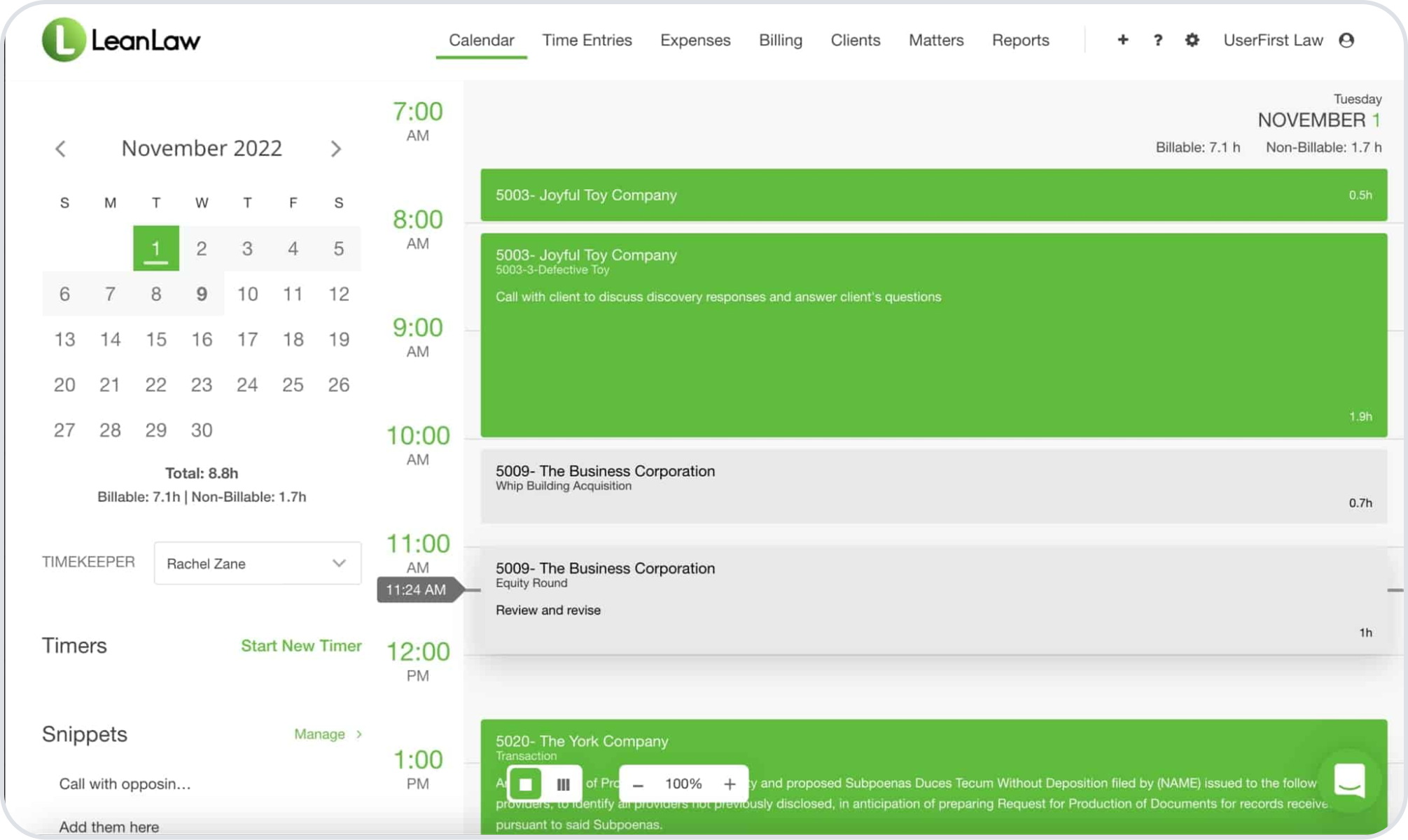
LeanLaw is best suited for smaller law firms for its user-friendly interface and no-fuss time trackers. Attorneys can track time using desktop, mobile, or browser timers, and they can edit time entries from bulk-entry or calendar views. This makes it easy for them to record every billable moment and visualize daily responsibilities.
LeanLaw also stands out for its tight integration with QuickBooks Online, which automatically syncs time entries and expenses with clients and matters, eliminating the need for manual client invoicing and accounting.
Features:
- Time tracking.
- E-payments.
- Invoicing and expense tracking.
- Billing increments.
- LEDES compliant invoice format.
Pricing:
7-day free trial. Afterward (billed annually):
- Core: $55 per user per month.
- Pro: $75 per user per month.
- Elite: Contact sales.
- Add-ons: Priority support, Custom reporting, Unlimited invoices, and Compensation tracking.
Key differentiator: Two-way QuickBooks sync for real-time receivables monitoring without leaving LeanLaw.
How to Choose the Best Legal Time Tracking Software for Your Firm
The best attorney time tracking software for you depends on your needs. To start narrowing down your options, answer the following questions:
- What's your firm's budget and size?
- What features matter most to each role?
- What programs will it need to integrate with?
Match by firm size
Your time tracking needs differ based on your firm’s size and budget. While all law firms should be moving away from manual time tracking via pen and paper, small firms typically prioritize in-app timers, simple interfaces, and reminders to boost adoption and control costs.
Larger firms usually focus on advanced workflows and automatic time tracking to reduce administrative overhead for attorneys handling multiple cases. These firms will also want complementary billing features, like trust accounting and expense tracking, to streamline invoice generation and client payments without platform-hopping.
Match by role needs
What time tracking features are most important to your staff will change depending on their role. Attorneys need features that automatically capture billable hours, like auto-capture or daily activity reports, so they don’t rely on their memory.
Meanwhile, administrative staff will look for capabilities that automate billing, accounting, and payroll tasks. Office managers want time and expenses automatically synced to the correct matters and clients, to speed up invoice generation. HR teams want clock-in and out widgets and geolocation features to track and pay non-exempt staff. And accountants want integrations with their preferred accounting platforms for monitoring business finances.
Match by existing tech stack
Choose tools with native integrations for your daily apps, especially CRM and practice management platforms. Connected programs reduce data entry errors and eliminate duplicate work from toggling between systems.
Frequently Asked Questions About Legal Time Tracking Software
What is legal time tracking software?
Legal time tracking software are systems that allow attorneys to record and manage their billable and nonbillable hours and expenses for accurate client invoicing.
Many time tracking platforms include billing and accounting features to create a one-stop shop for managing and monitoring your law firm’s revenue.
Why do law firms need time tracking tools?
Law firms need time tracking tools to minimize the chance of billable hour oversight, which could result in lower realization rates. Time tracking tools provide automations, timers, accounting integrations, and UTBMS code options, so every hour is accounted for and correctly invoiced.
What features should I look for in legal time tracking software?
Top features for legal time tracking software include:
- Access to timers via mobile, desktop, and browser.
- Expense tracking.
- Easy-to-navigate interfaces.
- Workflow automations, such as reminders for critical events.
- Integrations with case management, CRM, accounting, and calendaring systems.
- Billing capabilities, including configurable minimum increments, LEDES-compliant invoice formats, trust accounting, and e-payment options.
Can Lawmatics Time Tracking integrate with my existing systems?
Yes! Lawmatics integrates with popular programs, including Clio, 8am™ MyCase, PracticePanther, QuickBooks Online, iCal, Gmail, and Microsoft Outlook.
Explore Lawmatics’ integration catalog for more.
How much does it cost?
Time tracking software costs vary by firm size, features, and whether it’s a standalone product or part of a software suite. Generally, standalone time trackers cost anywhere from $10-$40 per user per month.
However, standalone trackers often lack features of purpose-built legal time and billing suites, adding unnecessary workflow steps and creating inefficiency.
Check out Lawmatics’ pricing page for an idea of what to expect in a legal CRM platform with time and billing capabilities, and connect with us for an exact quote.
Improve Your Law Firm’s Time Tracking Process With Lawmatics
The right legal time tracking software lets attorneys capture every billable hour and provide detailed client explanations, so your firm gets paid.
It shouldn't leave attorneys racking their brains to recall every filing, draft, and intake from the past week.
Lawmatics is the only platform that ties lead generation with time tracking, providing comprehensive insights into your firm's profitability drivers. You gain data insights into the most productive staff members, reduce the administrative burden of your office managers, and increase the efficiency of your client billing processes.
If you’re ready to streamline your workflows and ensure no billable hour slips through the cracks, schedule your Lawmatics demo today.
Documents are a critical part of any legal intake, but they’re also one of the easiest places for things to get messy. Whether it’s missing information, outdated templates, or slow turnaround times, small issues can add up fast. That’s why it’s so important to have a document workflow that’s tightly connected to the rest of your process, especially when it comes to forms, automations, and e-signatures.
Hosted by Product Manager Devon Butler and Clare Struzzi, manager of the account management team at Lawmatics, the session walks through how to use Lawmatics to build dynamic documents, pull in the right data, and automate the intake process all the way through to a signed agreement.
Time stamps of key takeaways
7:15 – Creating a new document
Devon walks through how to build a document using the Start Fresh option in Lawmatics, which is the recommended editor. She covers everything from adding headers and footers to inserting merge fields and signature blocks. Clare also shares tips on how to handle formatting, like where to place page breaks and how to use conditional logic blocks effectively based on practice area, without needing separate documents for each.
21:00 – Customizing content with merge fields
In this section, Devon explains how merge fields pull in data from both the contact and matter to personalize each document. She shows examples like merging in retainer amounts, scope of representation, and current dates. Clare also highlights how firms often use consultation notes forms to pre-fill these fields, so everything’s ready to go by the time a document is sent.
29:32 – Sending forms / merging data from forms
Devon and Clare walk through how forms and documents work together. Using a form lets you collect the exact information needed to populate an e-signature doc, things like fees, payment plans, or incident details. They also cover when to set fields as required and explain when to trigger sends in an automation, as opposed to manually reviewing before sending.
36:18 – Internal vs external forms
Not all forms are built the same. Devon explains that internal forms can’t be sent via automation — even to internal users — so marking a form as external is key when it's part of a workflow. They also share how to pre-fill fields like lead attorney using hidden defaults, and how to time form delivery (e.g., sending to a lead attorney 10 minutes before a consultation) using appointment-based automations.
Webinar slide deck
Choosing the best legal software for business billing depends on various factors such as the size of the firm, specific needs, budget, and preferences. Fortunately, comprehensive legal billing software for small firms can track billable hours, generate invoices, and manage client accounts efficiently.
How do You Simplify the Billing Process at a Law Firm?
Some strategies to simplify the billing process include:
- Standardizing billing practices across the firm with consistent templates, billing codes, and invoicing procedures
- Setting clear billing guidelines that outline rates, billing increments, and accepted payment methods
- Using legal billing software that automates time tracking, invoicing, and payment processing
- Integrating legal billing tools with case management systems to easily track billable hours and expenses
- Accepting online payments is convenient for clients and encourages them to pay promptly
For law firms, the time between completing a task and collecting a client’s payment is critical. When you streamline the billing process at a law firm, you can significantly improve efficiency and reduce administrative burden. Plus, simplifying the billing process shortens the time frame and increases profitability.
What is a Good Billing Software for Law Firms?
Before choosing billing software, a law firm should ensure that the system meets its specific needs and requirements. Here are some important considerations to make:
- Features: Evaluate the features offered and determine if they align with the firm's billing processes and requirements.
- Ease of use: Choose billing software that is intuitive, user-friendly, and easy to navigate, with clear instructions and minimal training requirements.
- Customization options: Look for billing software that provides the ability to customize invoice templates, billing rates, billing codes, and reporting formats.
- Integration capabilities: Ensure that the software integrates seamlessly with other systems used by the firm, such as practice management software, accounting software, and document management systems.
- Scalability: Choose a billing system that can scale with the firm as it grows to accommodate an increasing number of users, clients, and matters without sacrificing performance or functionality.
- Cost and pricing structure: Evaluate the cost of the billing software, including any subscription fees, implementation costs, and additional charges for add-on features or support services.
- Customer support and training: Look for vendors that offer responsive customer support, comprehensive training resources, and ongoing assistance to address any issues or questions that may arise.
- User reviews and recommendations: User reviews and recommendations from peers can provide valuable insights into the software's strengths, weaknesses, and overall suitability for the firm's needs.
The right legal billing software will enhance a firm’s efficiency, accuracy, and client satisfaction with the billing process.
Legal Billing System Examples
When selecting a billing system, it's essential to consider factors such as the firm's specific requirements, budget, ease of use, integration capabilities, and customer support. With Lawmatics, lawyers can simply start a timer and get to work. When they’re done, they’ll have an accurate time log that auto-populates directly into an invoice that can be reviewed or adjusted before being sent to a client. The result? A legal billing process that’s easier than ever.Which Software is Best for Business Billing in the Legal Field?There are many legal billing software systems to choose from, including:
- Lawmatics. Time and billing software that offers unparalleled visibility and reporting on billable hours, expense tracking, accounts receivables, and profitability for each team member — in real-time.
- Clio. A cloud-based legal practice management software that offers robust billing features that enable time tracking, invoice generation, trust accounting, expense management, and reporting.
- Quickbooks. While not specifically designed for law firms, QuickBooks Online is a widely used accounting software that can be integrated with Lawmatics to directly sync invoice data to the platform.
- LawPay. A system that integrates with various Lawmatics features to seamlessly send invoices, trigger automations upon payment, and enable access to all key data related to invoices sent.
Although there are many legal billing systems available to law firms, many providers offer free trials or demos, allowing firms to evaluate the software before making a commitment.
Is There Free Billing Software?
Yes, many paid platforms offer free versions suitable for smaller law practices or individual practitioners who want basic billing functionality without the cost associated with premium software. However, paid legal billing systems typically provide more advanced features, better support, and greater compliance with legal industry standards.
Which Software is Best for Business Billing in the USA for Small Businesses?
- The best invoicing software for small businesses must be simple, straightforward, functional, and allow for customization to accommodate the unique billing needs of small law firms.
- The best billing software for small businesses should automate repetitive billing tasks like time tracking, invoice generation, and payment notifications and reminders so that lawyers can put billing on autopilot and focus on client matters.
With flexible time tracking and custom billing rates, Lawmatics helps law firms of all sizes provide a client-focused billing experience. To learn more about how you can bill your clients in a way that makes everyone happy, request a demo today.
As Abraham Lincoln once said, “A lawyer’s time and advice are his stock in trade.” Attorneys provide their clients with their knowledge of the law, and in turn, clients pay them. Unlike buying something from the store which is a simple transaction, paying for legal services come with much more detailed line items. And although many lawyers are turning towards alternative billing methods like a flat-rate billing system, plenty of lawyers still bill by the hour. As you well know, legal advice doesn’t always come in neat one-hour slices. Sometimes it can be a 37 second phone call, or a 17-minute consultation. A client’s final bill must break down these intervals of legal counsel into an easy-to-read, detailed format so that the client knows exactly what they’re paying for.While this may sound simple in theory, billing clients can be extremely lengthy and exasperating for lawyers. From preparing the invoices to sending them out to getting paid, the entire process can take weeks to complete. And unfortunately, since administrative tasks like billing are non-billable, lawyers find themselves dwindling precious time and resources that they could be dedicating to billable work.There’s a better way. Say hello to Lawmatics' new legal time and billing systems.
Spend less time on billing and more time on billable work
Every second counts when increasing your law firm’s profitability and Lawmatics is committed to providing the tools that make it possible to focus on the bigger picture of your practice. Instead of losing time on the time-draining administrative side of your job, our legal invoicing technology makes it possible to turn your attention towards what you do best — practicing law.Lawmatics’ new Time & Billing software refines your billing technique in ways that result in less work for you and make a lasting impression on your clients. Easily create beautiful customized invoices that deploy within minutes and wow your clients with your modern and swift approach to accepting payments.
Batch invoices
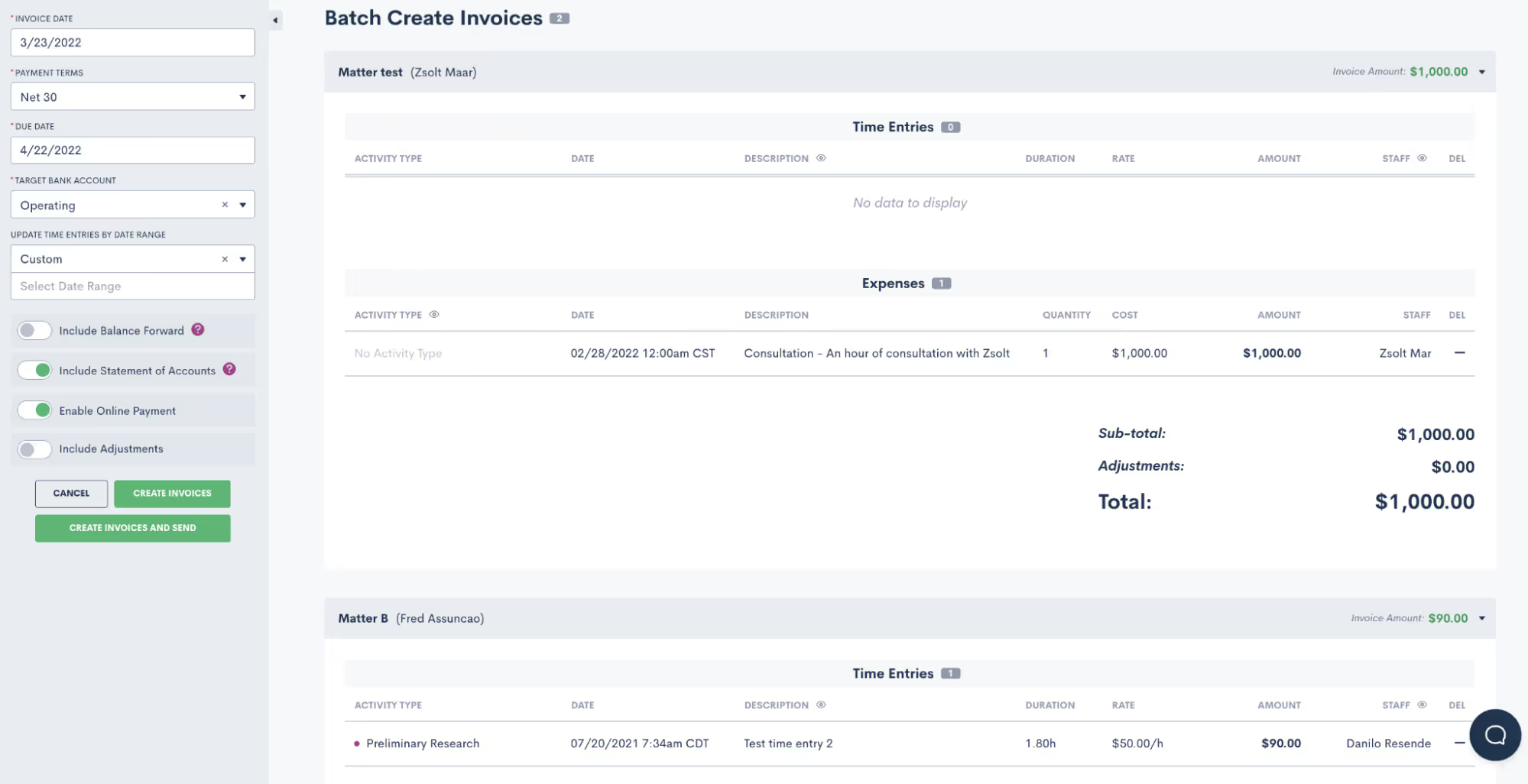
Generating bills one by one is as time-consuming as it gets. With Lawmatics, you can batch create invoices for multiple clients simultaneously. All you need to do is select clients from your list of matters whose statuses show as ‘unpaid.’ In a few clicks, all selected clients with balances due receive a digital invoice. You can also create invoices based on criteria of your choosing from date range of a matter to lead attorney, selecting and batching clients as needed.All of your invoices can go out in one sitting instead of having to prepare and send out individually, significantly saving your law firm time. Cue angelic voices singing!
Deliver polished, customizable invoices

Not only can you customize branded invoices with your law firm’s unique look, feel, and logo but you can also customize which columns of information you want to appear on the final bill. Add your own activity and expense types, whether it’s trial prep or copies and faxes, non-billable activity, or forwarded balances. Should you want to apply a discount or make a tax adjustment, It’s easy to make changes to the final invoice as needed — in other words, you can create your bill your way. You can even set your own default billing rates per user and per activity type, which means less time lost on data entry — simply click, select, and send.
Easily track your time
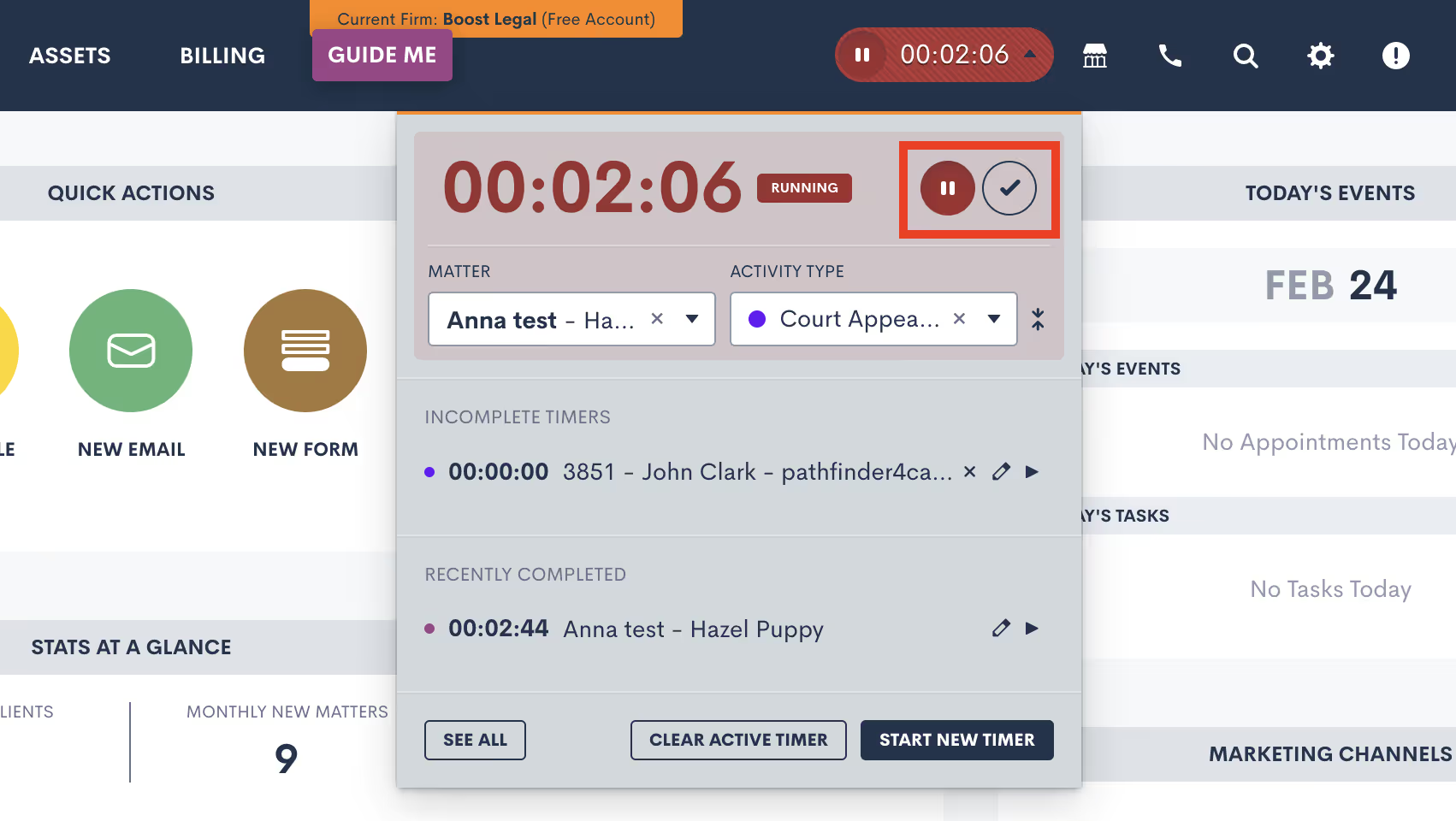
Perhaps one of the most exciting parts of Lawmatics' new Time & Billing software is the timer function that makes it easy to track your time. The minute you start a billable activity, simply launch a timer in one click and select an activity type from the drop-down menu. Whether you’re on a call or in a consultation, the timer will continue running in the background as you navigate the platform as you complete the task, ensuring you never miss a second of billable work.Once your activity is finished, simply mark it as complete and it will neatly file itself into your time entry list within the matter. How’s that for simplicity?
Makes it easy to track client trust accounts
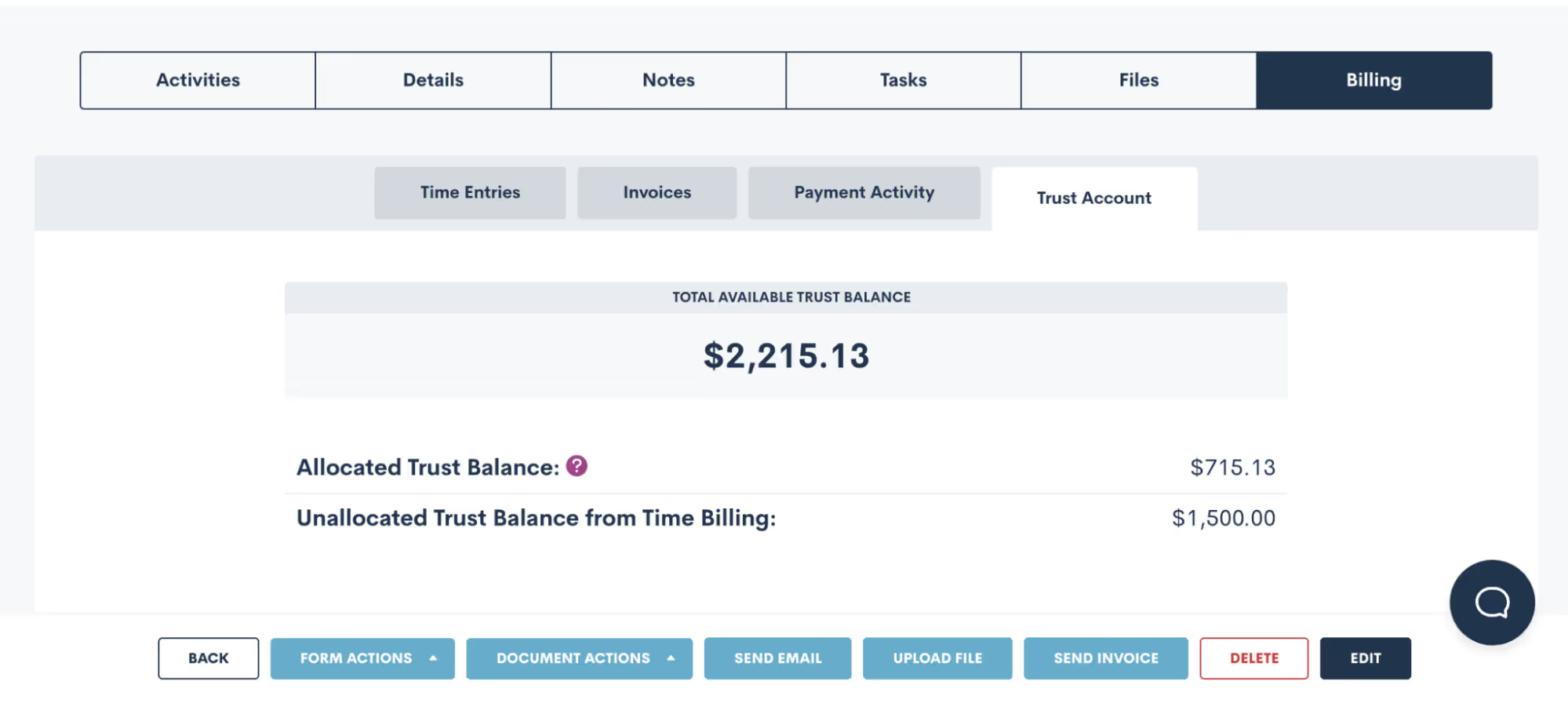
A lawyer’s worst nightmare is facing potential disbarment as a result of a mismanaged attorney trust account. Yet tracking incoming and outgoing trust account transactions isn’t always easy with non-legal-specific software. With Lawmatics, which was made for lawyers by lawyers, you can sleep peacefully knowing that all funds submitted into trust and transferred to your operating account are carefully tracked and reconciled with detailed notes.Easily run reports by matter to verify that your total balance matches your IOLTA account for the same time range. If you’re ever audited, you can be confident that Lawmatics can produce your trust balances matter by matter in a clean and easy-to-read format.
Get paid faster
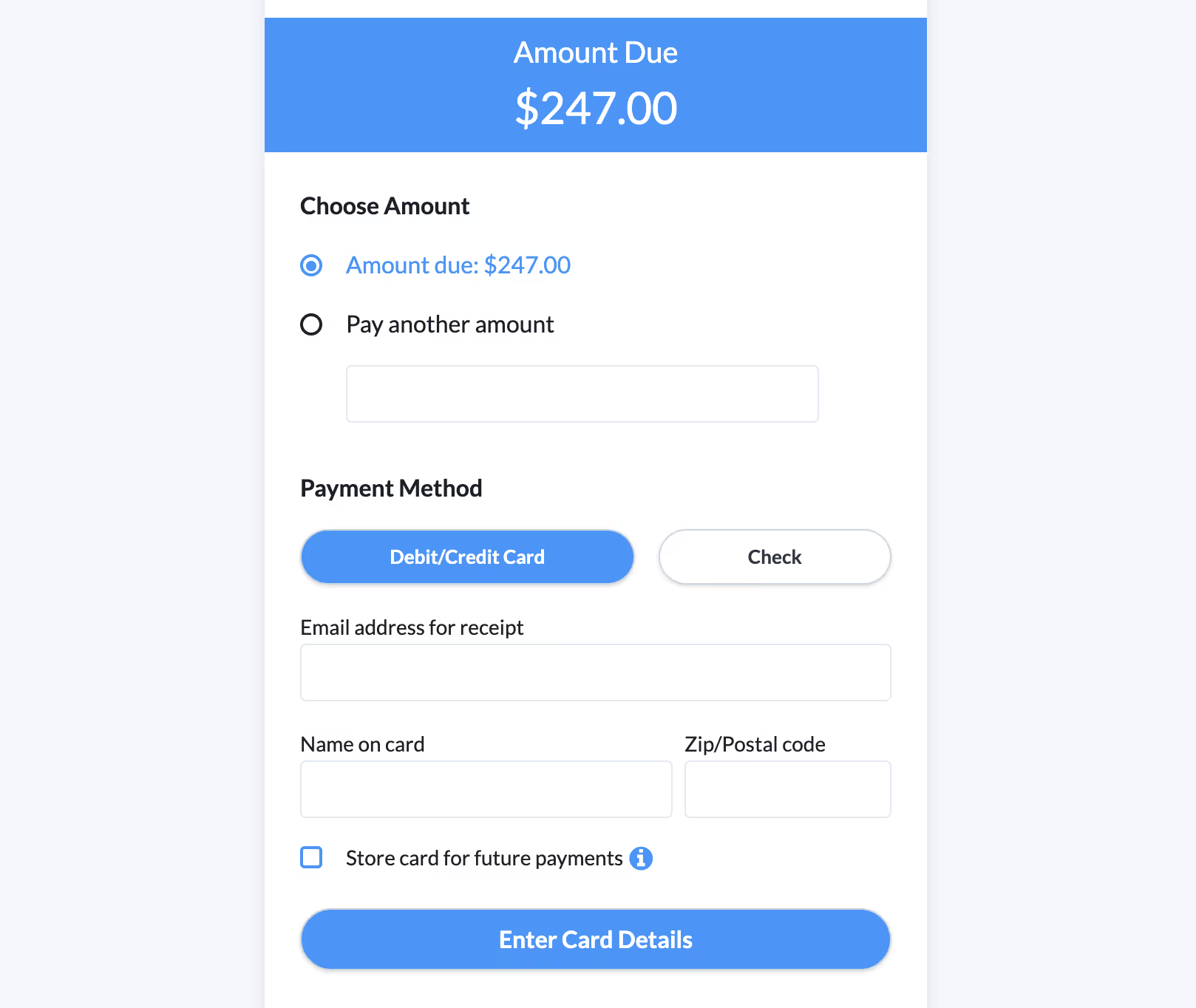
Outstanding balances can be an issue when you’re relying on an outdated billing system. Lawmatics lets your clients access a payment link directly from their invoice and pay instantly. No more bothering with checks, or mailing out paper bills — with Lawmatics you can streamline your billing and collect your money faster.Clients can pay with their preferred form of payment, whether by credit card, debit, or ACH, all from the palm of their hand. When you make it so easy for your clients to pay you, the less you have to worry about being paid.
Run data-driven reports
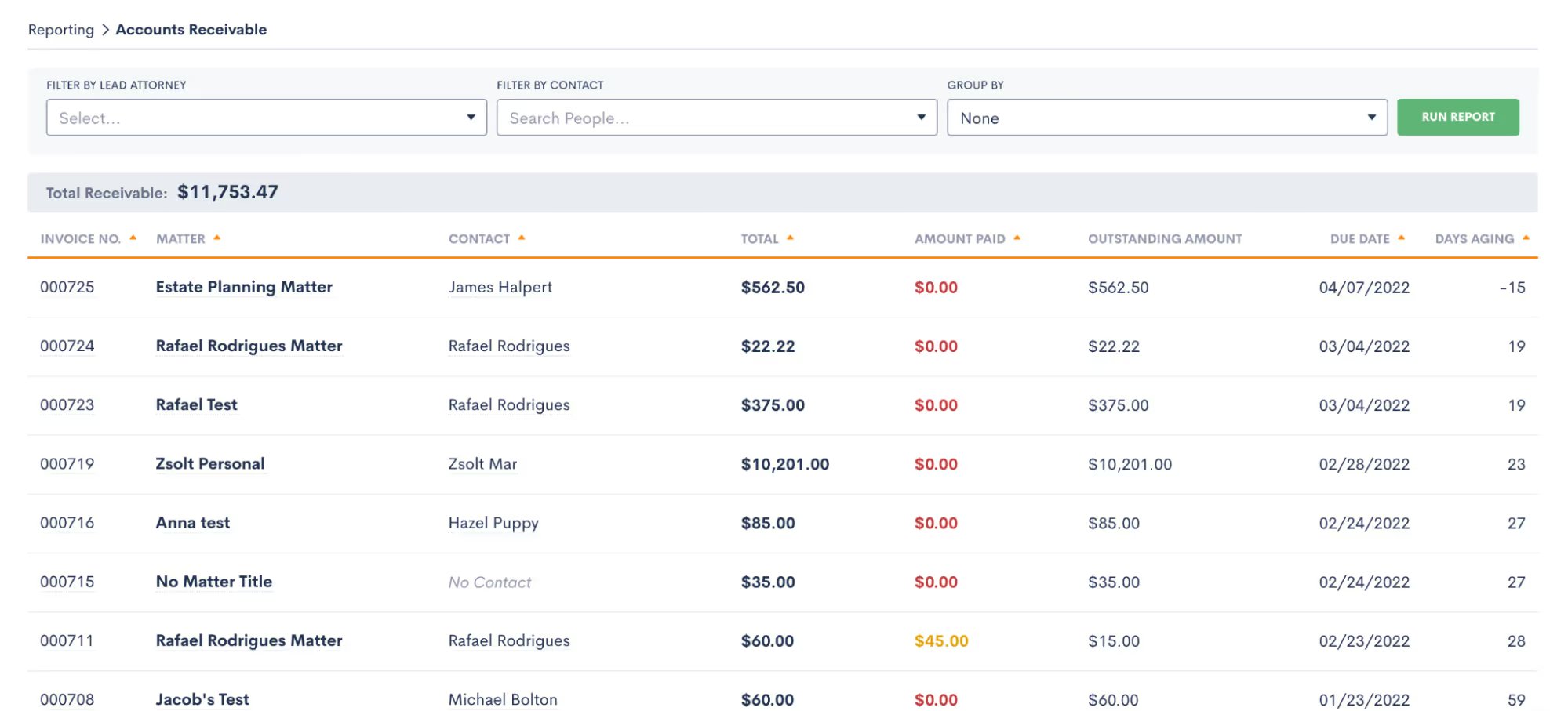
Keeping your finances on track is easy thanks to data-driven reports that show your law firm’s most important insights. Rather than bouncing around between multiple programs that conflate your financial data, Lawmatics is your all-in-one solution. See who your most profitable clients are, which attorneys among your legal team are the most productive, and track your balance collected versus balance billed. You can even monitor your average fee per matter, and make better-informed decisions based on data, not guesswork.
Tips for streamlining your law firm’s billing process
Create a standardized billing process
A 2019 Trends Report found that 14% of hours invoiced to clients never get paid. While there are a few factors that contribute to this statistic, it usually boils down to the same core problem: a lack of a standardized billing process.To avoid wasted time and other billing bottlenecks, it helps to get everyone on your team thoroughly acquainted with this process. Create a standardized billing process that specifies everything from when invoices are deployed, what expenses and activities should be billed for, and any additional communications and reminders that should go out with invoices and post-delivery.The more thorough your document around your billing process, the higher the accountability and lower the chances of human error. Regardless of the size of your law firm, a well-documented billing process facilitates a better understanding and recollection of your workflow to the benefit of your entire practice.
Be as specific as possible in your billing descriptions
Billing descriptions can be a lawyer’s catch 22 — create too brief of a billing description and you could find yourself with a dissatisfied client that feels cheated. However, add an overly verbose description that takes up three pages of an invoice, and you'll have your office manager working overtime. Instead, it’s considered a best practice to aim for a specific, detailed, yet concise description that leaves your client feeling satisfied with the number they're paying.Ideally, your activity descriptions should look something like “met with client to go over real estate assets” or “ telephone call from opposing counsel” — keep it short and sweet, yet anything but vague.
Be forthright and transparent about your billing process
One of your first action items upon initial consultation is confirmation from your clients that they understand your fee agreement and billing process. Consider this an essential component of lawyer billing ethics. The best way to do this is to put it all in writing to assure that you and your client understand each other. You should go over the total amount of money you charge, your hourly rates, anyone else on your team who will be working on the case, when your invoices will be sent out, a detailed description of an estimate of total expenses, and when you expect to be paid.Putting this in writing doesn't just make this easier for you and your team, but it also helps your clients better plan for paying their bill. Better planning means less likelihood of having to chase your clients around to settle up.
Formally train your team to use your billing software
Whether you're a small firm, or you're a larger one with an office manager and paralegals handling your billing, it's important that everyone on your team fully understands the inner workings of your billing software to get the most out of it. Appoint someone in your firm — whether that be you yourself or a team member — to take point on getting all staff members trained on your billing solution. This person will be in charge of communicating with onboarding representatives of your billing platform and schedule training sessions with your staff as time permits.Lawmatics' full platform comes with a thorough onboarding program designed to help your firm get off to a running start. At the end of the Lawmatics onboarding program, your team will be well versed on every feature of the Lawmatics law firm CRM, client intake marketing automation and billing platform. Following onboarding, your team will continue to have access to our knowledgeable support team to answer any questions and concerns.
Track time contemporaneously
If you hope to keep a steady cash flow, you must stay on top of your time tracking. Doing so contemporaneously — or as billable work happens — is a method experienced attorneys swear by to hit your billable hours goals. With so many things going on at once in your law practice, it’s easy to forget to log your billable work later on, or worse, overestimate the length of an activity on your invoice and infuriate your clients, leading to billing disputes. Use the Lawmatics timer function to ensure that you stay on top of every minute of billable work, and you might just be surprised to find that you’ve been working more than previously estimated.
Consider alternative billing methods
More and more lawyers are turning towards alternative billing arrangements given the stigma of the term “billable hour” and its frequent association with astronomical and unaffordable legal bills. Consideration of alternative billing arrangements may help you tap into a greater legal market of clients that may not have otherwise hired you on an hourly billing system. On top of that it can also create a more straightforward billing process for you and your team.Flat fees, for instance, are easy to invoice, and rarely result in billing disputes. If you haven't at least begun to consider introducing alternative billing methods into your law firm, now may be a great time to start. Since more and more lawyers are charging for their legal services in alternative ways, failing to keep up could put your competition at an advantage.
Use automation whenever possible
Automating your law firm’s routine tasks is the best way to streamline your practice, and dedicate your time to what can’t be automated — like strategizing or attending hearings. Above all, automation helps boost your law firm's productivity, so your workday isn't bogged down with administrative tasks like invoice preparation, or data entry.By harnessing the power of legal technology like Lawmatics you can make time for your law firm's most valuable work, and let automation handle the rest. From invoice reminders to generating a fee agreement in a matter of seconds, automation is here to make your billing process go much smoother.
The future of legal billing technology is here
A recent report shows that the average legal professional logs less than 3 billable hours a day on average since they're so inundated with non-billable administrative work like billing clients.Legal technology is evolving every minute, so there's no reason why your billing system shouldn't evolve alongside it in pursuit of your profitability goals. And when it comes to profitability, time is your most important asset. Not only in billing but law firm performance management and new client intake can all be streamlined to give you more time. The more you can accelerate day-to-day processes with modern solutions, the higher your caseload allotment, and the more revenue you can generate.Whether your law firm bills hourly, on contingency, or by fixed fee, Lawmaticslegal billing software is a clear-cut billing solution for thorough invoicing that makes it easy to get paid. Are you ready to see how Lawmatics’ new time and billing feature can level up your billing process? Sign up for a free demo today!Sources CitedClio, 2019 Legal Trends Report, 2019https://www.clio.com/resources/legal-trends/2019-report/Clio, 2021 Legal Trends Report, 2021https://www.clio.com/resources/legal-trends/
Billing can be a time-consuming and frustrating process, but it is necessary for your firm's success. To control your billing workflow, you need to step back and consider the whole billing cycle from an organizational standpoint. Review your billing cycle for opportunities to increase efficiencies, identify roadblocks or obstacles, and strategize how to simplify your legal time and billing system.
The typical law firm billing systems
Logging billable time and expenses, creating a draft bill, and sending the final bill to clients are the three main elements of a profitable billing process for a law firm. Usually, law firms will bill clients at the end of each month or even bi-weekly, but this may vary depending on the type of case and the amount of time involved.When a new client onboards, attorneys will track and log their billable time throughout the case matter. The attorney's activities are compiled into a draft bill at the end of the billing period. Attorneys, or additional stakeholders, will review the invoices, add notes and adjust costs as needed before approving the invoice. Once approved internally, the bill's final version is sent to the client for payment.Most law firms offer multiple payment methods (e.g., check, credit card, or wire transfer). Clients may set up a payment plan in some cases, but that is at your firm's discretion. Once payments are received, the accounting team will send out follow-up reminders regarding any late payments.While this legal billing process is relatively succinct, there's plenty of room for bottlenecks on implementation. Let's walk through how to streamline your billing processes.
Write a billing policy that works for your law firm
The goals of a billing process are to provide a system for tracking time and expenses, ensure that bills are accurate and timely, and provide a clear and concise explanation of services offered to clients. Having a standardized billing policy in place helps to achieve these goals.
Visualize the entire billing workflow
Write out all of the steps that need to happen during your billing process. Be as detailed as possible. When you write out the entire flow of your billing cycle, it becomes much easier to identify any bottlenecks or areas where time is wasted. You can also see which steps can be streamlined or automated. Having a standardized billing policy in place will also help to ensure that bills are accurate and sent out on time.
Include templates & guides for your staff
There's no need to reinvent the wheel each time. Your billing policy should include templates and billing guidelines to make the process easier to automate — bonus points if your legal billing software automates and formats your invoice templates.There are a few reasons why it's important to have a standard invoice format:
- It makes it easier for your clients to get familiar with your time entries, legal fees, and outstanding payment. They know what to expect using the same format every time and can easily compare invoices.
- It helps you keep track of your expenses. When all your invoices are in the same format, it's easier to see where you're spending your money and identify any patterns.
- It helps ensure that your invoices are accurate.
Invoice elements
All invoices should include a few key elements to make them as straightforward as possible:
- Include the name and contact information of both the law firm and the client for easy reference if any questions or concerns.
- Include a detailed description of the services rendered to help avoid any misunderstandings about what was billed for and why.
- Make sure to include the total amount due, as well as the date by which it should be paid.
By having all of this information, you can ensure that your invoices are clear and concise, making them easy to understand and pay.
Invoice review guidelines
When thinking about invoice review, you can create billing guidelines or a checklist for the attorneys who need to review the invoices before sending them to clients. This way, every person is checking and assessing the invoices is referencing the same rubric.
Set standard rates & billing structure
When setting rates and fees for your law firm, there are many things to think about, like the type of legal practice, what other lawyers are charging for similar services, the overhead costs of your firm, and the experience and qualifications of your lawyers.The most common fee structures are:
- Hourly billing — This fee structure is the most common for lawyers who typically bill in increments of one tenth of the hour.
- Flat rate billing — This fee structure charges clients a set price for every case, regardless of how much work is involved, which can be an excellent option for clients who want absolute certainty about how much they will owe.
- Contingency fee — A contingency fee is a fee that you only have to pay if you win your case. This fee is often used in personal injury and medical malpractice cases where there is high risk and a high potential payoff.
One of the most important aspects of billing is consistency with your rates. A good invoicing solution will have the option to set rates per attorney.
Implementing an efficient legal billing practice
A plan is only so good without implementation. There are a few low-hanging practices that can make your office run smoother than before.
Bill for all the time you spend on a case
When you're billing for your time, make sure to bill for all the time you spend on a case. This includes meeting with clients, researching, drafting documents, and appearing in court. Keep track of your time contemporaneously whenever possible, and bill your clients accordingly. This will help ensure that you're getting paid for all the work you're doing and significantly improve your bottom line.
Providing multiple ways of payment
To make it as easy as possible for your clients to pay their bills, you should offer multiple ways of payment. This could include online payment options, such as PayPal or credit card processing, and offline payment methods, such as checks or money orders.Offering little to no flexibility when it comes to method of payment can be bad for your business because it makes it harder for your customers to pay you. If you only accept cash or check, for example, odds are slim that each of your clients has access to those. The less you limit the ways in which you can be compensated, the less likely clients are to default on payment.
The importance of being consistent with invoicing
Sending invoices out at regular intervals and using the same format for each invoice will help ensure that there is no confusion about what is being billed for, and it will make it easier for your clients to keep track of the balance they’ve paid and the balance they still owe.
Explain your billing process in your fee agreement
When drafting a fee agreement, you should clearly outline two things: your payment procedures and the payment requirements. Make sure the client knows your billing procedures & payment conditions. Be straightforward about your rates and explain when they can expect to receive the bill.The agreement will also contain other important information, such as the scope of work. This is an excellent opportunity to set expectations for the case matter.Be sure to explain how you will bill them, what type of billing system you will use, and how often they can expect to receive invoices. You should also let them know what your policy is for late payments.As you proceed with a case, it's essential to keep clients updated on the status of their bills. If there are any changes to the amount they owe, be sure to let them know as soon as possible. The last thing you want is for a client to be surprised by a large bill at the end of the month. By communicating with your clients about billing from the start, you can avoid any misunderstandings or conflicts down the road.
The importance of communication in billing
It's vital to maintain clear and open communication with your clients about outstanding payments.Here are some tips for effective communication during the billing cycle:
- Be clear and concise — When sending an invoice to a client, be sure to include all the pertinent information, including the amount due, date due, and any applicable late fees or penalties. Be sure to use clear and concise language to avoid confusion about what is being requested.
- Be prompt — Invoices should be sent out in a timely manner so that clients are not surprised by a large bill at the end of the month. If you are running behind on invoicing, be sure to communicate this to your clients so they can budget accordingly.
- Keep records — Be sure to keep accurate, meticulous records of all communications with clients, including invoices sent and payments received. This will come in handy if there are any disputes later on.
Reducing friction for your clients is a great way to provide high-quality service. A straightforward billing system makes it easier for clients to understand what they owe and more likely to pay on time. This focus on quality and convenience makes the law firm appear more professional and capable, building trust and strengthening relationships.
Using financial reporting to identify opportunities
Having accounting knowledge that is relevant for your business will help you determine the growth potential for your organization. Byproducts of good law office accounts provide valuable insights into firm performance. The data you collect can help you make better business decisions.Businesses need to review their financials to understand how well they are doing. This information can help businesses decide where to invest their money and how to improve their operations.Keep a close eye on outstanding debts, payments, and profits to keep your billing procedure on track. The following reports might assist you in maintaining the financial health of your legal practice and keeping your billing procedure running smoothly:
- The Accounts Receivable Report gives an overview of open and past due invoices on a per-user, per-client, and per-matter basis. You can see amounts owed for approved outstanding invoices and partial payments made towards those balances.
- The Accounts Receivable Aging Report classifies past due accounts receivables by age (e.g., bills that are unpaid more than 30 days old, less than 31 days old, and so on).
- The Billing History Report provides a comprehensive record of your clients' billings: open invoices, past-due invoices, and paid bills.
- The Matter Balance Summary Report is a report that displays outstanding debts, as well as how much work in progress and continuing expenses there are on a per-matter or per-client basis.
- The Trust Applied or Trust Transfer Reports the money that has to be physically transferred from trust to operating account. The Trust Transfer report can also act as an audit log, or backup, of the trust history and dollar amounts that have been transferred at the bank.
- Trust Replenishment Report shows the current trust account balance, amount of minimum required, and how much a client is below their minimum requirement.
- The Invoice Payments Report shows payments on individual cases for particular service and item expenses. It also identifies the people who are responsible for those line items.
- The Revenue Report is a tool that allows your company to see and measure key performance indicators for each user, client, and matter on a per-user, per-client, and per-matters basis. The report details unbilled, billed, and collected amounts in terms of hours, expenses, and taxes.
These reports can help you keep track of your law firm's billing procedure and identify any areas where improvement might be needed. By monitoring your accounts receivable, payments received, and profits, you can stay on top of your finances and ensure that your billing process is running smoothly.
5 things to look for in billing software
Using billing software is one of the best ways to keep your law firm organized and efficient. Good billing software will allow you to track your expenses, bill clients for those expenses, and keep track of payments received. It can also help you generate reports that give you a better understanding of your firm's finances.When it comes to finding the best legal billing software for your law firm, it's important to keep in mind the specific needs of your business. Here are 5 things to look for when choosing a billing solution:
- Ease of use — The software should be easy to learn and use, with a user-friendly interface.
- Flexibility — The software should be customizable to meet the unique needs of your law firm and those of your clients.
- Scalability — The software should grow with your business, as your needs change over time.
- Security — The software should be secure, with features that protect your data from theft or unauthorized access.
- Reporting — The software should include robust reporting capabilities so that you can track billing and payments activity.
An efficient billing cycle will help increase law firm profitability and build successful relationships with your clients. Good billing practices include communication, consistency, providing multiple ways of payment, and keeping accurate billing records. By evaluating any billing software using the aforementioned criteria, you can facilitate the best possible billing experience for you and your clients.
Make your billing process work for your staff & your clients
If you're struggling with invoicing, billing, and collecting payments from your clients, it might be time to invest in a cost-effective solution. Lawmatics' billing software is an excellent way for law firms to simplify their billing process and increase profitability. The software is easy to use and customizable for your billing rates to meet the unique needs of any law firm. Additionally, the software includes robust reporting capabilities to track billing and payments activity. This information can help firms improve their billing practices and better serve their clients.Finally, automated workflows in the software mean that lawyers can spend less time on administrative tasks and more time practicing law. If you're struggling with invoicing, billing, and collecting payments from your clients, Lawmatics' software is a cost-effective solution that can help your business grow.
Frequently asked questions
What forms of payment do law firms accept?
Most law firms accept major credit cards, checks, and wire transfers. Some law firms also offer financing options for their clients. This can be a great way to help them pay for your services. You should always be willing to work with your clients to find a payment option that works for them.
What to look for in legal billing software?
The best invoicing software options for law firms are those built with legal compliance in mind. Legal billing software will be able to help you track your time to a matter, automate and batch invoicing and keep track of payments.When it comes time to find legal billing software, there are a few key features to look for: ease of use, flexibility, scalability, security, and reporting capabilities. The software should be easy to adopt and implement user-friendly. It should be customizable to meet the unique needs of your law firm and able to grow with your business as your needs change over time.Billing software should also be secure, with features that protect your data from theft or unauthorized access. Finally, it should include robust reporting capabilities so that you can track billing and payments activity. By keeping these features in mind, you can be sure to find the best billing software for your law firm.
What are some common mistakes law firms make when billing?
One of the most common mistakes law firms makes when billing clients is not being clear or transparent about what they are charging for in their time entries. This can lead to confusion and frustration, and even stall the case..Another common mistake is not being consistent with invoices. The top way to keep yourself from getting paid is by surprising your clients. The final mistake that is all too common is not keeping track of expenses, which leads to inaccurate invoices and overcharging. Be sure to track all of your expenses to avoid any potential billing conflicts.
What does a legal billing specialist do in a law firm?
Legal billing specialists control billing activities within an organization. It can include billing, collecting payments, or preparing and presenting financial reporting for scrutiny.A billing specialist typically does the following in a law firm: billing, collecting payments and preparing/presenting financial reports for scrutiny. They are responsible for maintaining an orderly system of accounts and ensuring that all financial obligations are met on time. In addition, billing specialists may be involved in contract negotiations with clients or other legal professionals.Sources CitedBowman, D. (2021, January 16). Law Firm Billing: Five Ways To Ensure Your Clients Pay On Time. The National Law Review.https://www.natlawreview.com/article/law-firm-billing-five-ways-to-ensure-your-clients-paytime#:~:text=Many%20attorneys%20prefer%20to%20bill,your%20bill%20in%20one%20paymentMedice, M. (2022, February 16). 2022 Profitability Strategy Checklist. JD Suprahttps://www.jdsupra.com/legalnews/2022-profitability-strategy-checklist-2115538/Mann, A. (2021, February 11). Why Modern Law Firms Must Use Electronic Payment Solutions. LawPayhttps://www.lawpay.com/about/blog/electronic-payment-solutions-law-firms/Uniform Task-Based Management System. American Bar Association https://www.americanbar.org/groups/litigation/resources/uniform_task_based_management_system/2021 Report on the State of the Midsize Legal Market. Thomas Reuters https://legal.thomsonreuters.com/en/insights/reports/2021-state-of-the-midsize-legal-market-report/thank-you
As a new lawyer, law firm billing can be daunting. You want to make sure you're billing correctly and ethically, but you also don't want to spend too much time on billing (which is non-billable). If you're a summer associate or a new lawyer trying to navigate the challenges of billing, stay tuned to find tips for billing that will help you navigate the waters of legal billing.In this article, I'll discuss the most common billing methods for lawyers and the ethical duties when it comes to billing. I'll give tips on how to track your time efficiently, how to bill for various legal services, and how to handle client invoices.
MRPC 1.5. overview
Before we dive in, it's important to note (despite being obvious) that we'll discuss the Model Rules of Professional Conduct (MRPC) 1.5. Still, you will need to follow your state's Rules of Professional Conduct to ensure that you are compliant in your state.
What is a reasonable fee?
MRPC 1.5 discusses client agreements, attorneys' fees, and contingency fees. The main discussion in Model Rule 1.5 is what factors make a fee considered reasonable. The rule explicitly lists eight factors among those that determine if a fee is reasonable:
- Time and labor required, novelty & difficulty of issues, a skill required
- The likelihood that would preclude other employment
- The fee customarily charged for similar services and in similar areas
- The amount involved and results obtained
- Time limitations under which operating
- Nature and length of the relationship
- Experience, reputation & ability of the lawyer
- Whether the fee is fixed or contingent
While the eight factors listed in Model Rule 1.5 are not exhaustive, they provide a good starting point for determining what is considered a reasonable fee. Keep in mind that each state's Rules of Professional Conduct may have additional factors to consider when determining reasonableness.When billing your clients and ensuring law firm profitability, be sure to take into account the time and labor required, the difficulty of the issues involved, as well as your skill level and experience. And always remember to be transparent with your clients about what you're charging them.
Put the fee agreement in writing
When it comes to legal billing, it's essential to put the fee in writing. A fee agreement, sometimes known as a retainer agreement or a representation agreement, is a legal contract that describes the terms of the attorney-client relationship. The agreement should specify your legal fees and who will work on the issue.A written fee agreement will ensure that both you and your client are on the same page, and it will help prevent any misunderstandings; your client can refer to it later if there are any questions or disputes about the bill.The fee agreement should state:
- How much money you will charge
- The lawyer's hourly rates
- A mention of anyone else in the lawyer's office who works on the case
- How often you will invoice
- A description of expected expenses
Considerations for contingency fees
A contingent fee agreement needs to be in writing and signed by the client. That fee agreement needs to explain the basis of the fee, including the percentage, and detail any specifics like percentage to the law firm in the event of settlement, trial, and appeal.If you take a case on a contingent fee basis, you agree to assume financial risk. So, if the case is a loss, you will not recover any fees. It's imperative to detail all expenses the client may be liable for in case of a loss at the start of the matter.If applicable, the client fee agreement should detail expenses that will be deducted from the recovery. Note if the costs will be deducted before or after calculating the contingent fee. Finally, the agreement must notify the client of any expenses for which the client might be liable.
7 Common issues with billing practices
Model Rules 8.4 and its state counterparts restrict behavior that includes deception, fraud, and misrepresentation. Below are some of the common pitfalls that include misrepresented fees and services.
1Double billing
At its most basic definition, double billing is when you invoice two clients for work done during the same time period. If you end up doing an hour of research that can apply to two matters, split the difference and invoice each client .50 (30 minutes).Double billing becomes more of an issue if you are traveling for a client matter but end up doing work for a second client during the travel downtime. It's great to be proactive, but you might be better off single-tasking on the primary matter at hand.
2Block billing
Lumping together many distinct tasks into a single billing entry is block billing. This billing practice is dubious because you fail to accurately report the time it took for each task individually. Timesheets need to be clear and easily interpreted by someone reviewing them.There may be instances where block billing is appropriate, like during travel. But generally, avoiding block billing is a best practice that benefits the client, and if a fee dispute later arises, you'll be thankful you took the time to have accurate timesheets.
3Marking up your time
Inflating your time spent working is the same as marking up your time. Only invoice for your time working on a matter to ensure that you are not overcharging your clients and help maintain a good relationship with them.
4Excessive billing and "value" billing
This one might be a bit obvious, but be sure that you only bill for services provided when you bill your client. Some attorneys have claimed that the value of their services is enough to charge additional fees and high rates.Many fee disputes occur when a client perceives that an attorney has billed an unreasonable or excessive time on specific tasks. Unlike marking up timesheets, if there are legitimate reasons tasks took longer than anticipated, you can talk to your client and give them precise, descriptive time entries. You can use this dispute to educate a client about your work and potentially avoid a fee dispute down the road.
5Charging for unnecessary processes
Generally speaking, you will want to avoid wasteful, unnecessary, or redundant processes. There are instances of lawyers charging for unnecessary travel (think: this trip could have been an email).Of course, those are egregious circumstances. Start small in your work routine. As you get comfortable in your work processes, start seeing where you can trim down any inefficient processes. Pro tip: there is a lot of fat that can be trimmed when it comes to streamlining client intake.
6Maximizing your minimum time increments
Don't be the attorney who bills in half-hour or hour increments (yes, it's happened). The issue with billing at a slightly higher rate, even at .25 hours (15 minutes), is that there might be too much padding for the billable tasks. Billing at .25 hours might inflate the invoice. If there were to be a fee dispute, a higher time increment would be examined thoroughly.There will be a standardized rate at your law firm that you must follow. The standard increments, which are more about convenience, used by most firms are as follows.
- 1/10 of an hour (6 min)
- 1/6 of an hour (10 min)
- 1/4 of an hour (15 min)
Take a reasonable and balanced approach and choose the billing increment that is acceptable for your practice area.
7Charging clients for law office overhead
More simply put, do you bill a client for creating a bill? Clients do not expect to pay for your administrative tasks. It's best to remit tasks like accounting services to general services done by the law firm.The ABA has declared this unethical, but many states handle this differently. Some states say it's permissible to include overhead as long as you clearly state those fees in the client fee agreement. You can always reach out to your state's Ethics or Grievance department to talk through the appropriate billing practices for your firm.
11 Tips to get you from billing novice to invoicing all-star
When starting out as a young lawyer, it's essential to track your time efficiently, bill for various services, and handle client invoices. Practice makes perfect, and it is possible that introducing these methods can make you more efficient and effective.Billing clients is a highly challenging aspect of any practice. However, the company must develop a good timekeeping and billing process. Technology has helped with many complex tasks and considerably reduced the time involved.
1Know your law firm billing processes
Your law firm must establish a clear, documented billing policy that will give you a reference point and create a standardized process. But you'll find that billing processes vary between law firms. For example, some clients do not pay for meetings with other lawyers in the office, lawyer travel time, and time spent doing administrative tasks.
2Invoice requirements
There may be specific invoice requirements and formats at your firm. Typically, invoices require the matter name and unique identifier (usually a case number), a description of the work completed, and the timekeeping information (name, title, rate). Standardizing your invoices helps maintain consistent customer service, ensuring smooth billing processes.
3Explain the legal fees in the agreement
As it's one of the tenants of MRPC 1.5, it is critical to get everything in writing when it comes to legal billing. A representation agreement is a legal contract that gives a clear overview of the attorney-client relationship. You will specify the terms of your fees, your colleagues who will handle the problem, and the period you will work together.The attorney-client agreement can serve as a resource; in case there are any concerns or disputes regarding the bill, they can refer to it again. Ultimately, an agreement will guarantee that both you and your client are on the same page.
4Be a better time keeper
You can keep track of your time in different ways. It is essential to record the time you spend on work tasks as soon as you do them. You can use a legal pad, a billing program, or even your smartphone to do this.Additionally, you can estimate the amount of time a task will take before starting it. Knowing how long you expect to take on a task will help you stay on track and avoid underestimating or overestimating the amount of time a particular task will take.The most important thing is to be consistent in keeping track of your time. This way, your records will be accurate.
5Start using minimum time increments
Instead of jotting down something as short as two minutes and 38 seconds for email or 46 seconds for document submission to the customer and putting it all up, use the 10-tenth hour minimum time increment. Any task, or set of tasks, that is one to six minutes denotes 0.1, or a tenth of an hour. From there - you scale up, so between 8 - 12 minutes is 0.2, 13 - 18 minutes becomes 0.3, etc.Experienced senior lawyers utilize this billing best practice to ensure their time is never under-reported, as it helps to add more value to the minutes. Check with your law firm to see their standard minimum time increment.
6Enter time daily
From here, I think you're getting the hint that the more frequently you track your time, the better odds of capturing an accurate picture of your work daily.One way to ensure that you track your time daily is to make it a habit. You can do this by setting aside a specific time each day to review your time entries and update your timesheet, which will help you stay on top of your work and ensure that your billing records are accurate. Time and billing software makes this as seamless as possible. Read our post on legal process outsourcing for more information.
7Single task
Single-tasking means that you do one thing at a time. So, when you are editing a brief for a matter, you aren't also answering phone calls or checking email. To be better at single-tasking, you need to create an environment conducive to it. So, turn off notifications on your phone and computer, close any unnecessary tabs in your internet browser, and keep your workspace organized. You may also want to set time limits for how long you work on certain tasks so that you're not distracted by other things.
8Don't underestimate your time
Underestimating your time can happen for two reasons. First, if you are not keeping consistent records of your tasks, you may forget tasks, like phone calls, you've completed. This omission will make it appear you spent less time on a matter than you did.The other reason for underestimating time is that sometimes new lawyers think they should be faster as a task than they are. Talk to your manager instead of getting in your head about your speed and pace. Ask them what amount of time they expect tasks to take. In the meantime, those tasks to you the time you tracked- so write it down.
9Break down your entries
As for the billing entries, divide the tasks into separate entries to make sense of the cost of the time. For example, a review of medical records does not require time if it is voluminous. The bill is for "Review and preparation of draft medical documentation ." Give the customer several pages and why this project is beneficial.
10Itemize your bills
Start noting the timed breakdown of your tasks and activities on your bills. Itemizing your bills will help you avoid block billing. Below is an example of a detailed time-tracked list.02/22/2022: Zoom conf. with expert witness Wardle (1.0); reviewing documents for cross prep (.3); sent comms to and from client re: files(.3); reviewed new eDiscovery files (2.4); prepared exhibits for defendant (1.5); Zoom conf. with court for motions (.5).Total: 6.0 hours
11Master your billable time
Tracking your time diligently and detailed with a law firm CRM will add administrative time to your workday. But the lasting value is that you won't have to go back to recreate a day or weeks' worth of billable time-- which would be nearly impossible to do accurately.You have a responsibility to your clients, which is why billing ethics are so important. The tips we've outlined today should help bill with ease and efficiency. Remember, following these steps will ensure you maintain professionalism in all aspects of your practice. It not only helps you stay out of trouble but also creates transparency with your clients.At Lawmatics, we understand the importance of proper attorney billing and invoicing procedures. That's why we offer software that helps attorneys stay compliant with ethical standards while also getting paid on time. Our team is passionate about assisting lawyers in succeeding, and we're here to answer any questions you may have about our products. Contact us today to learn more about how Lawmatics can help your firm streamline its billing process and increase collections.
Frequently asked questions
?How do new lawyers get better at billing?
New lawyers can do a few things to get better at billing. First, they should track their time accurately and break down their tasks into separate entries. This will help them to understand the cost of the time they are spending on each activity. Second, new lawyers can itemize their bills using detailed timesheets to avoid block billing.Finally, they should master their billable time to bill clients for the work they have completed accurately. By following these tips, new lawyers can bill easier and ensure that they are getting paid for their work.
?How do you calculate billable hours for a lawyer?
To start calculating billable hours, you need to know your minimum time increment for work. Most attorneys invoice in increments of six minutes, but some law firms choose to bill in 10-minute or 15-minute increments.Lawyers need to track their time and break it down into specific tasks to calculate billable hours. Itemizing an invoice gives transparency into how much each service or activity costs.When billing by the hour, it's important to keep track of the time you're spending on each task. This will help you stay organized and ensure that you're billing accurately. You should also break down your tasks into separate entries to understand the cost of each activity.
?Do lawyers double bill?
Double billing is when a lawyer bills a client for the same work twice. This can be an ethical issue, as it can misrepresent the lawyer's time and services to the client.Double billing can also be illegal in some cases, leading to overbilling of clients. Lawyers who double bill may be subject to disciplinary action from their state bar association.Lawyers need to avoid double billing to maintain transparency with their clients. By billing accurately and honestly, lawyers can build trust with their clients and avoid potential issues.
?What are the most common types of billing methods for lawyers?
There are three common types of billing methods for attorneys. The type of practice typically dictates which method a law firm will use.Hourly rates are the most common type of billing method for lawyers. The hourly billing method uses a fixed rate, and the lawyer charges for the amount of time spent on a matter.Fixed rates are a common billing method for lawyers. With a fixed rate, the lawyer charges a set price for the scope of their work. Both parties are aware of the cost of the work ahead of time.Contingency fees are a fee arrangement in which the lawyer receives a percentage of the damages awarded to the client. Alternatively, the lawyer can receive a set amount regardless of the case's outcome. This fee arrangement is common in personal injury cases and is beneficial to both the lawyer and the client.
?What are the ethical duties of a lawyer when it comes to billing?
There are several ethical duties that lawyers must adhere to when billing. First, they must be accurate and truthful in their billing statements. Lawyers should not misrepresent the time they spend on a task or the services they provide. Second, lawyers must charge a fair and reasonable fee for their services, so they cannot overcharge or bill for work not completed. Third, lawyers should avoid double billing to maintain transparency with their clients. By billing accurately and honestly, lawyers can build trust with their clients and avoid potential issues.
Sources Cited
American Bar Association, Rule 1.5: Fees, April 14, 2020 https://www.americanbar.org/groups/professional_responsibility/publications/model_rules_of_professional_conduct/rule_1_5_fees/American Bar Association, Rule 1.5: Fees — Comment, August 16, 2018 https://www.americanbar.org/groups/professional_responsibility/publications/model_rules_of_professional_conduct/rule_1_5_fees/comment_on_rule_1_5/American Bar Association, Ethical Considerations for the Future of the Billable Hour, Scott Groverhttps://www.americanbar.org/groups/young_lawyers/publications/tyl/topics/ethics/ethical_considerations_the_future_the_billable_hourAmerican Bar Association, Tasty Solutions to Timekeeping, Billing, and Accounting, Ann M. Guinn, February 17, 2021 https://www.americanbar.org/groups/gpsolo/publications/gp_solo/2014/july-august-2014/tasty_solutions_timekeeping_billing_and_accounting/State Bar of Wisconsin, Ethical Dilemma: Can You Bill a Client for Creating the Bill?, APRIL 04, 2018 https://www.wisbar.org/newspublications/insidetrack/pages/article.aspx?Volume=10&Issue=6&ArticleID=26264Billing Pitfalls and Pratfalls: Avoiding the Ethical Issues that Snag Attorneys https://www.manhattan-law.com/wp-content/uploads/2019/08/Billing-Pitfalls.pdfLexology, Good billing practices is an ethical duty, Randy (J. Randolph) Evans, Shari L. Klevens and Alanna Clair, November 21 2016 https://www.lexology.com/library/detail.aspx?g=aee19c1c-451c-401b-b954-36ddd3f3a55fHGexperts.com, The Client's Guide to Law Firm Overbilling, https://www.hgexperts.com/expert-witness-articles/the-client-s-guide-to-law-firm-overbilling-25863







